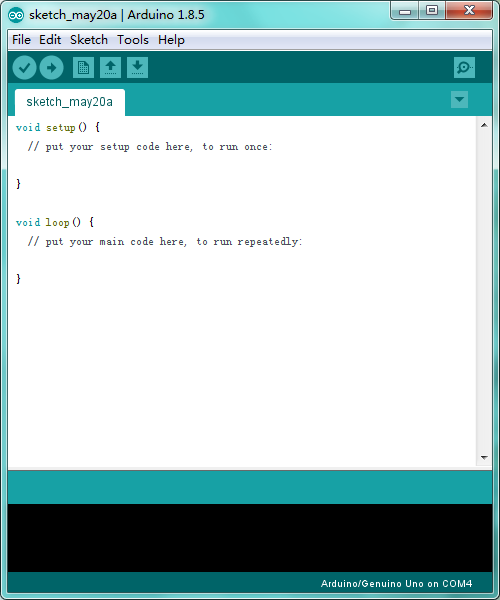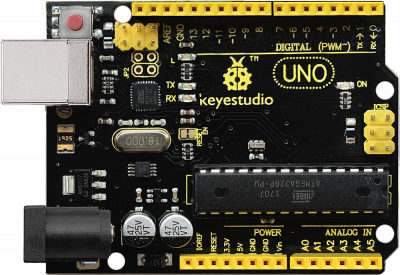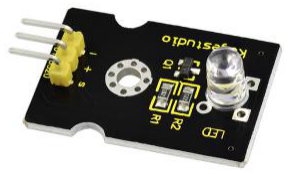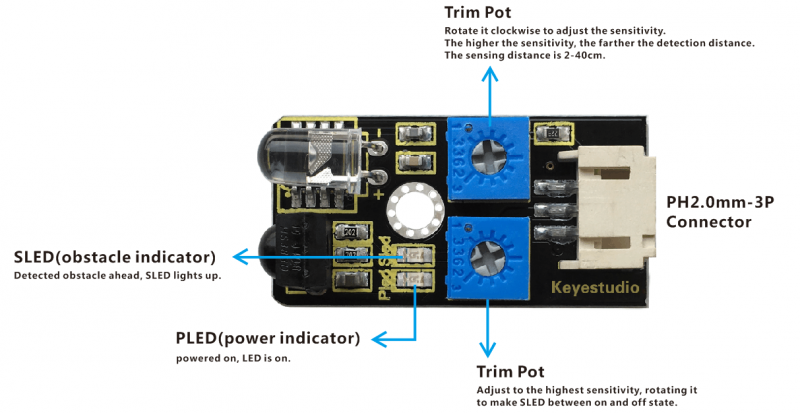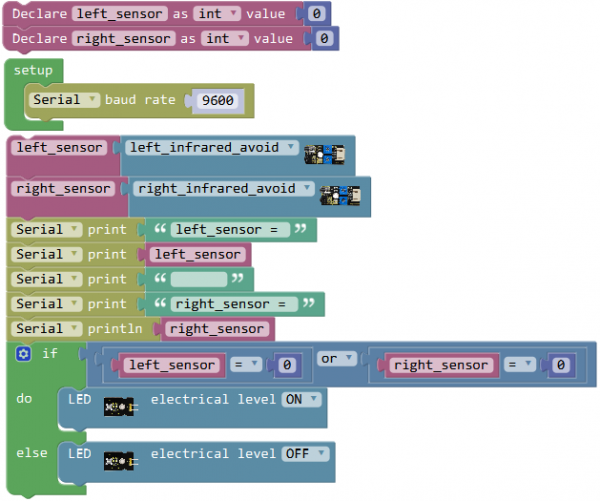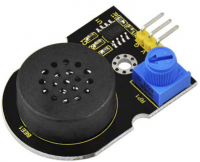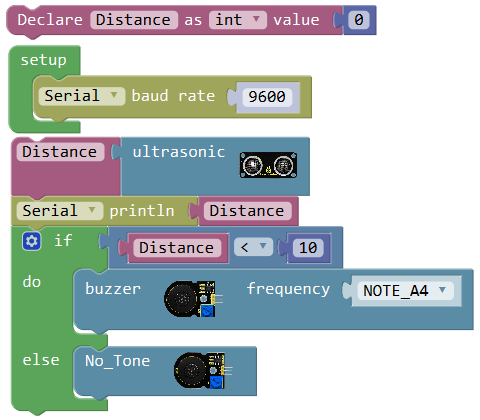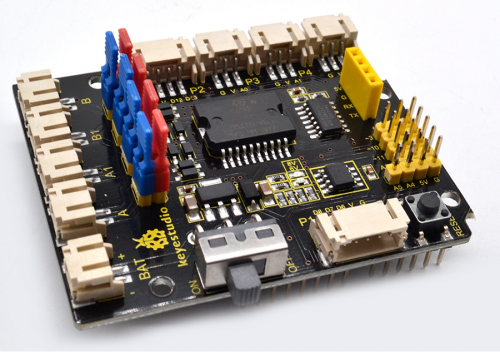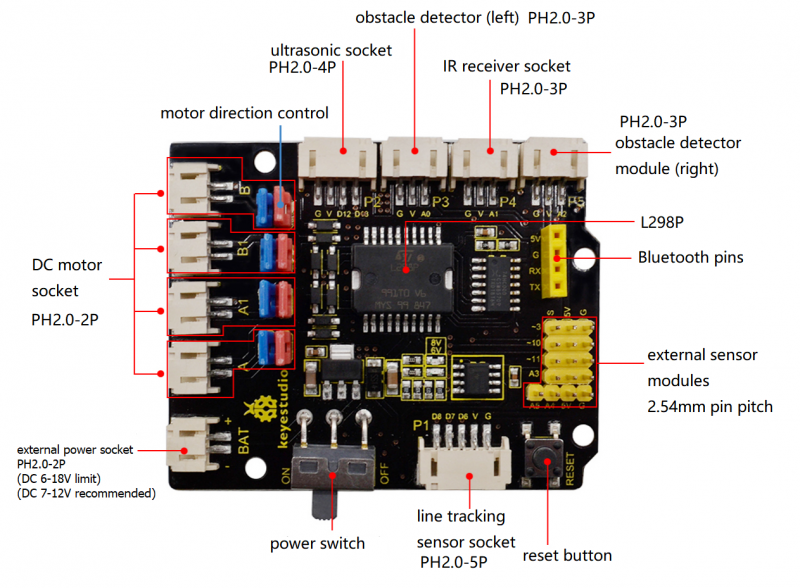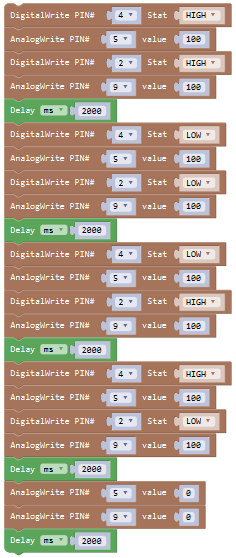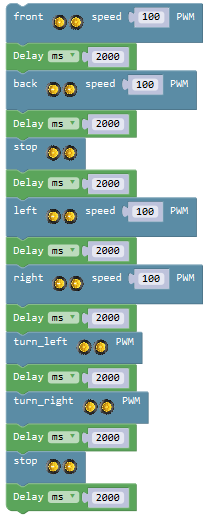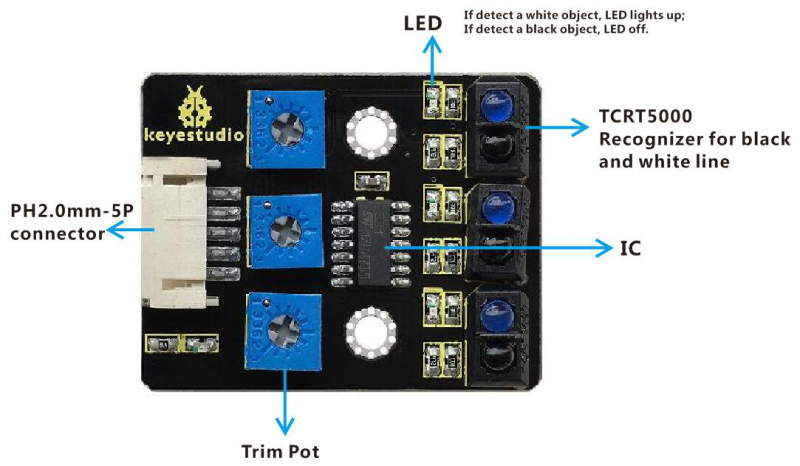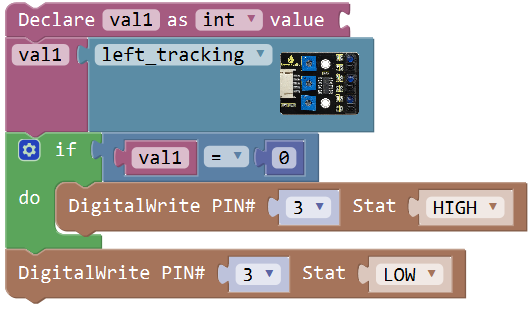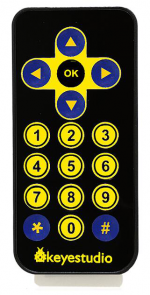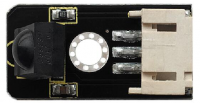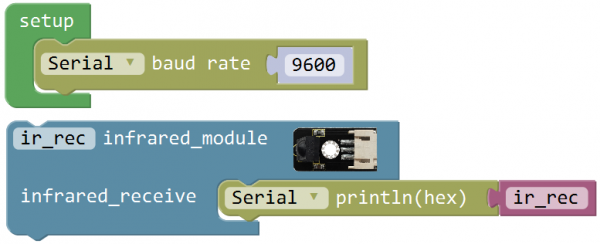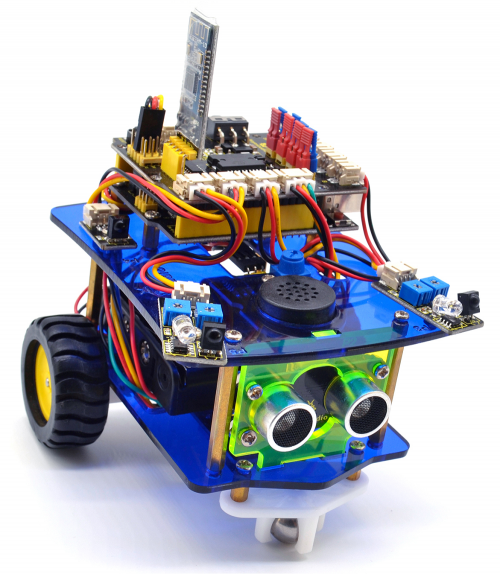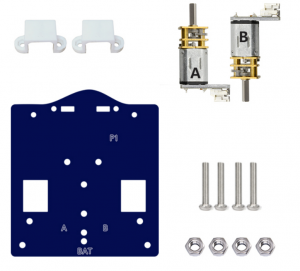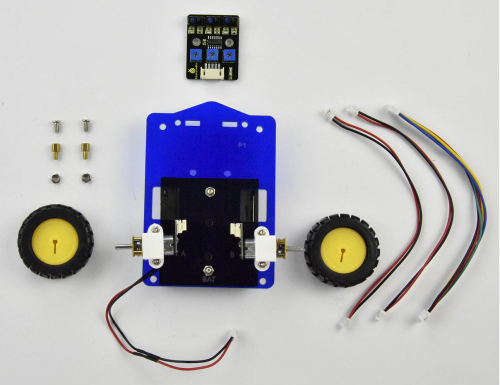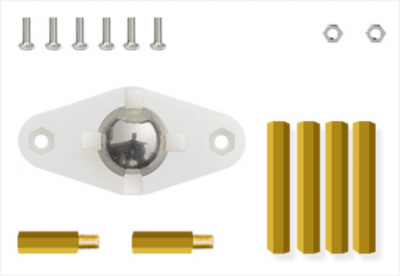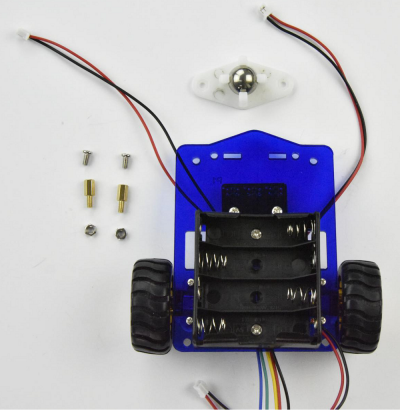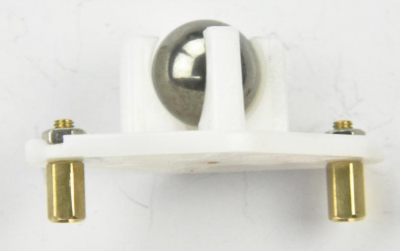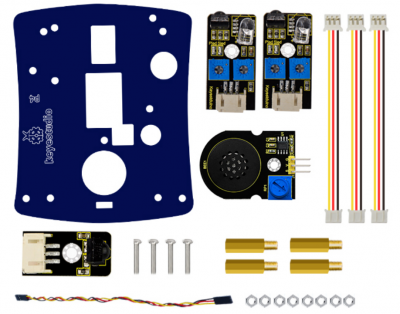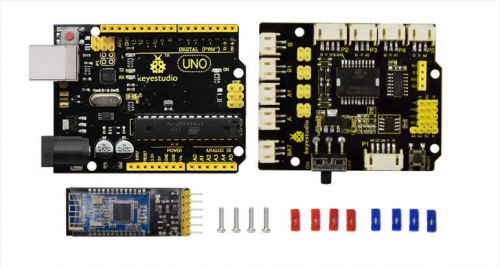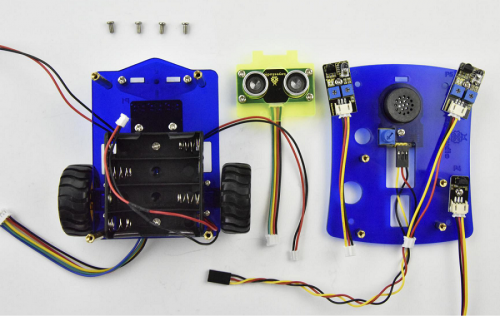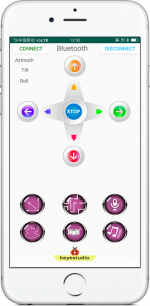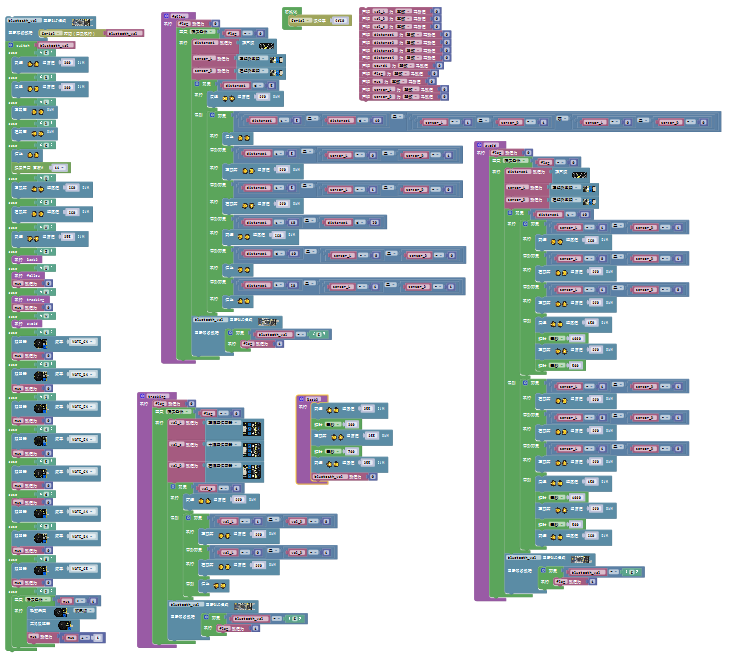Ks0441 Keyestudio Desktop Mini Bluetooth Smart Car V3.0
Description
We can often see others on the internet making use of control boards and electrical components to build their own creative robots. Wanna DIY your own robot?
Here comes keyestudio desktop mini Bluetooth smart car V3.0, which is an upgraded version of keyestudio desktop mini Bluetooth smart car V2.0.
The smart car still keeps the functions like line tracking, obstacle avoidance, IR and Bluetooth control and more.
Furthermore, we make a great improvement for the smart car as follows:
- 1) The Acrylic plates are more bright and colorful;
- 2) Adding a microphone sound module to make a fantastic sound when driving the car run;
- 3) Using Bluetooth HM-10 module,which can support Bluetooth 4.0; supporting both Android and iOS system; also can actuate the smart car with our own designed Bluetooth APP.
- 4) Can freely choose the battery case 18650 or 4-cell AA battery case to supply power for the robot car. Note that batteries are Not Included. Users can freely choose two 18650 batteries or four AA batteries (1.5V) to supply power for the robot car.
- 5) Making improvements on the motor drive board; one is coming with a slide switch for controlling the power switch;the other is adding 8 jumper caps to control the DC motor direction,easy for code debugging.
- 6) Coding the robot car with Mixly blocks software, simple and ready to play.
From the basics up to complex projects, through this kit you can learn to control the robot car with Mixly blocks coding. Easy to code and learn coding and computational thinking.
If you are looking for inspiration, you can find a great variety of tutorials here. Take your brain on a fun and inspiring journey through the world of programming and electronics.
Parameters
- 1)Motor Voltage range: 1-6V; motor shaft length: 10mm; speed: 6.0V 100rpm/min.
- 2)Motor control is driven by L298P;
- 3)Three groups of line tracking modules, to detect black-white line with higher accuracy and can also be used for anti-fall control;
- 4)Two groups of obstacle detector modules, to detect whether there are obstacles on the left or right side of smart car; Ultrasonic module is used to detect the distance between ultrasonic and obstacles, forming the smart car’s obstacle avoidance system;
- 5)Bluetooth wireless module can be paired with Bluetooth device on mobile phone to remotely control smart car;
- 6)Infrared receiver module is matched with an infrared remote control to control the smart car;
- 7)Can access the external 7 ~ 12V voltage.
Component List
When get this smart car kit, at first glance, you will see the beautiful packaging box. And each component is safely packed inside the small bag in order.
You will get such a bulk of components and screws to make your own smart car. So we have listed all the components as follows:
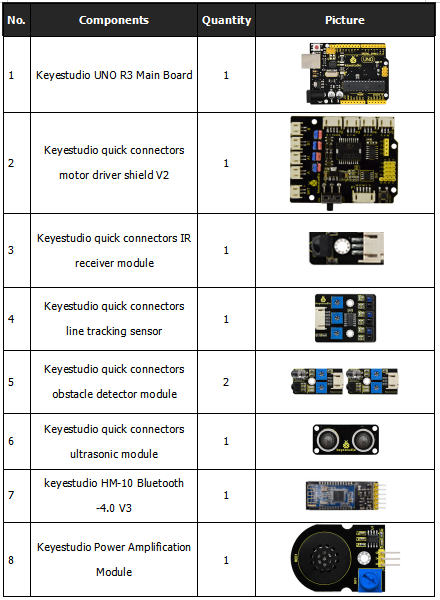
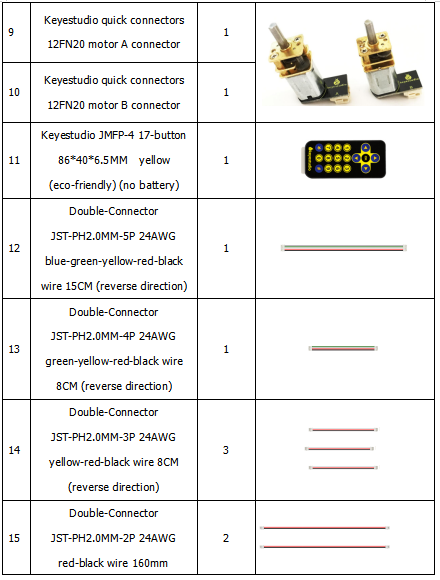
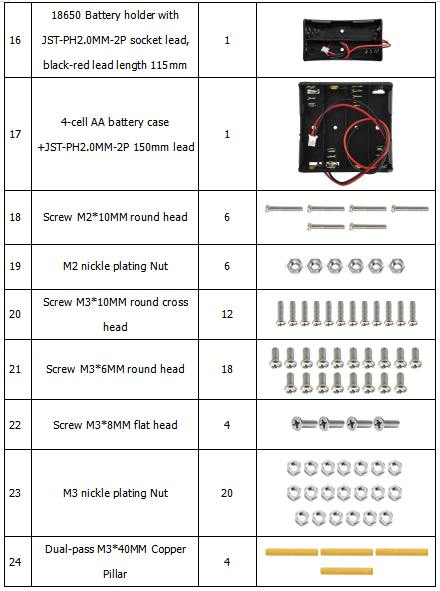
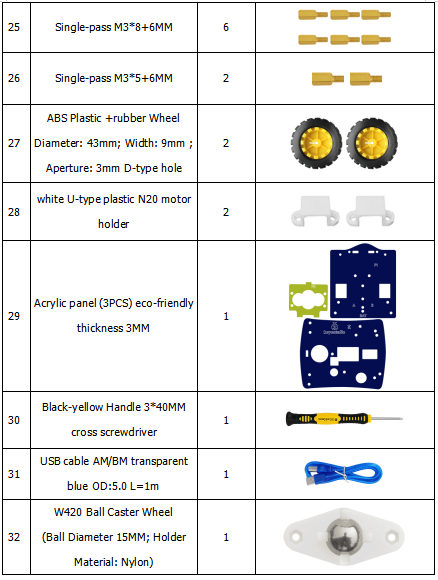
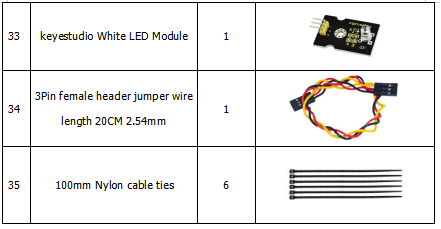
Software Introduction
1)Installing Arduino IDE
When program the UNO development board, you can download the Arduino integrated development environment from the link:
See more contents at:
- https://wiki.keyestudio.com/Getting_Started_with_Arduino
- https://wiki.keyestudio.com/How_to_Download_Arduino_IDE
- https://wiki.keyestudio.com/How_to_Install_Arduino_Driver
- https://wiki.keyestudio.com/How_to_Install_Arduino_Library
The functions of each button on the Toolbar are listed below:
![]()
Or you can browse the KEYESTUDIO website at this link, https://www.keyestudio.com/ and then click on the WIKI Tutorial.

2)Introduction for Mixly Blocks
Mixly is a free open-source graphical Arduino programming software, based on Google’s Blockly graphical programming framework, and developed by Mixly Team@ BNU.
It is a free open-source graphical programming tool for creative electronic development; a complete support ecosystem for creative e-education; a stage for maker educators to realize their dreams.
More info please check the link to download the Mixly blocks software.
- https://wiki.keyestudio.com/Getting_Started_with_Mixly
- https://wiki.keyestudio.com/Download_Mixly_Software
- https://wiki.keyestudio.com/How_to_Import_Mixly_Library
Before starting the robot projects, please click the link to get the basic understanding of Mixly software.
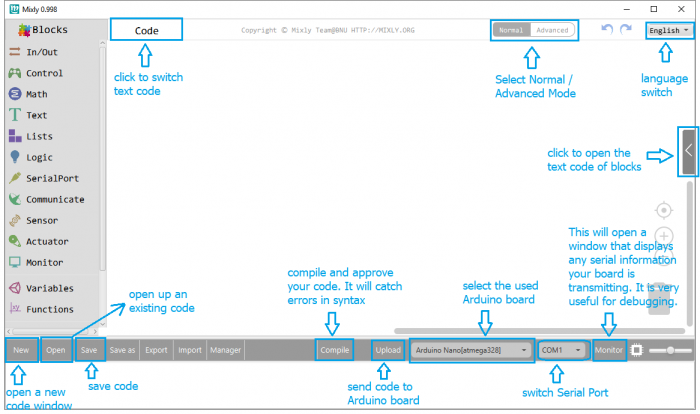
3)Import Robot Library
For the robot kit, we have developed keyestudio robot car library.
Don’t forget to import the keyestudio desktop car library to Mixly software before coding the robot projects.
Must import the robot car library first, or else you CANN'T check all the test code.
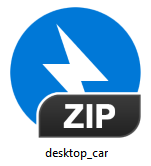
Unzip the desktop_car library package, you can see the desktop_car XML.document.

Then import this document into Mixly library. Import custom library successfully!
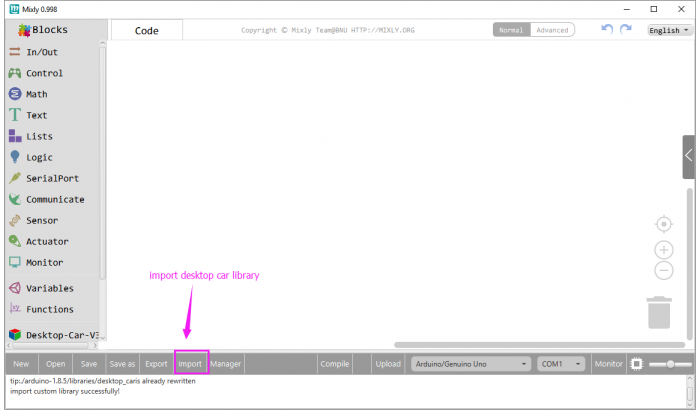
You are able to click “Manager” to manage all imported libraries.
Note: sometimes it may exists a conflict between libraries, so should keep only correct car library when using and delete other library.
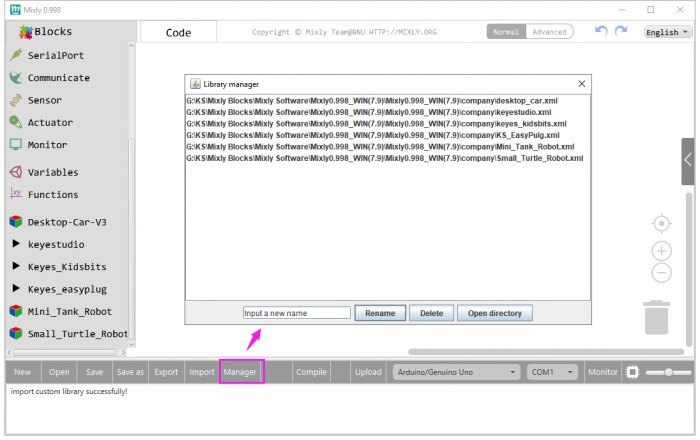
Projects Guide
Project 1: Built-in LED
When it comes to using the UNO R3 as core of our robot, the UNO is the best board to get started with electronics and coding.
If this is your first experience tinkering with the platform, the UNO is the most robust board you can start playing with.
Well, let's at first have a look at this UNO R3 board.
Here is an explanation chart of what every element and interface of the board does:
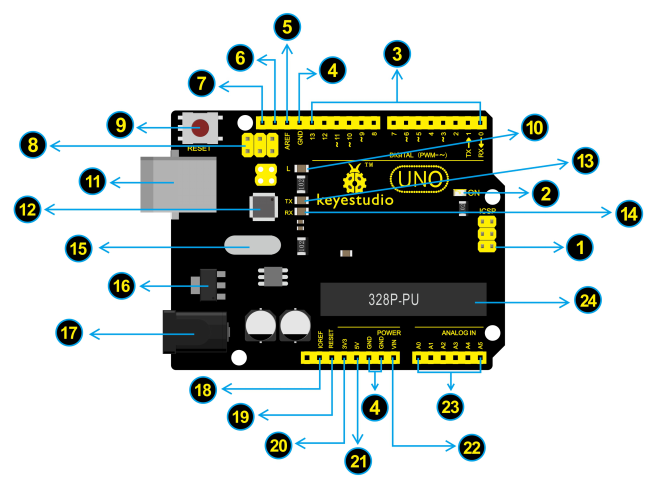

|
ICSP (In-Circuit Serial Programming) Header
In most case, ICSP is the AVR,an Arduino micro-program header consisting of MOSI, MISO, SCK, RESET, VCC, and GND. It is often called the SPI (serial peripheral interface) and can be considered an "extension" of the output. In fact, slave the output devices under the SPI bus host. |

|
Power LED Indicator
Powering the Arduino, LED on means that your circuit board is correctly powered on. If LED is off, connection is wrong. |

|
Digital I/O
Arduino UNO has 14 digital input/output pins (of which 6 can be used as PWM outputs). These pins can be configured as digital input pin to read the logic value (0 or 1). Or used as digital output pin to drive different modules like LED, relay, etc. The pin labeled “〜” can be used to generate PWM. |

|
GND ( Ground pin headers)
Used for circuit ground |

|
AREF
Reference voltage (0-5V) for analog inputs. Used with analogReference(). |

|
SDA
IIC communication pin |

|
SCL
IIC communication pin |

|
ICSP (In-Circuit Serial Programming) Header
In most case, ICSP is the AVR,an Arduino micro-program header consisting of MOSI, MISO, SCK, RESET, VCC, and GND. Connected to ATMEGA 16U2-MU. When connecting to PC, program the firmware to ATMEGA 16U2-MU. |

|
RESET Button
You can reset your Arduino board, for example, start the program from the initial status. You can use the RESET button. |

|
D13 LED
There is a built-in LED driven by digital pin 13. When the pin is HIGH value, the LED is on, when the pin is LOW, it's off. |

|
USB Connection
Arduino board can be powered via USB connector. All you needed to do is connecting the USB port to PC using a USB cable. |

|
ATMEGA 16U2-MU
USB to serial chip, can convert the USB signal into serial port signal. |

|
TX LED
Onboard you can find the label: TX (transmit) When Arduino board communicates via serial port, send the message, TX led flashes. |

|
RX LED
Onboard you can find the label: RX(receive ) When Arduino board communicates via serial port, receive the message, RX led flashes. |

|
Crystal Oscillator
Helping Arduino deal with time problems. How does Arduino calculate time? by using a crystal oscillator. |

|
Voltage Regulator
To control the voltage provided to the Arduino board, as well as to stabilize the DC voltage used by the processor and other components. |

|
DC Power Jack
Arduino board can be supplied with an external power DC7-12V from the DC power jack. |

|
IOREF
Used to configure the operating voltage of microcontrollers. Use it less. |

|
RESET Header
Connect an external button to reset the board. The function is the same as reset button (labeled 9) |

|
Power Pin 3V3
A 3.3 volt supply generated by the on-board regulator. Maximum current draw is 50 mA. |

|
Power Pin 5V
Provides 5V output voltage |

|
Vin
You can supply an external power input DC7-12V through this pin to Arduino board. |

|
Analog Pins
Arduino UNO board has 6 analog inputs, labeled A0 through A5. |

|
Microcontroller
Each Arduino board has its own microcontroller. You can regard it as the brain of your board. |
Let’s make a simple test for the UNO built-in LED (D13).
We will work on blinking an LED. That’s right - it’s as simple as turning a light on and off!
Now enough talking - let’s get started with the LED project.
Blinking an LED
It’s pretty simple to turn a built-in led on and off. We only require UNO R3 control board and a USB cable to enter the wonderful programming world.
Connect your UNO R3 board to the computer’s USB port using a USB cable for communication.
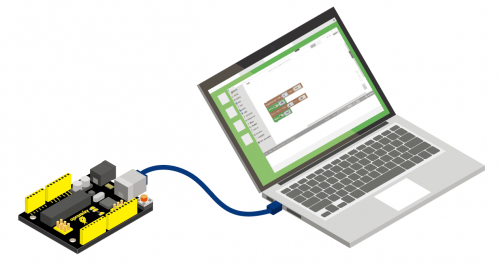
Test Code:
Open Mixly blocks platform to get started with coding.
First, click IN/OUT, drag the “DigitalWrite PIN# (0)Stat(HIGH)” block.

This block is used to set the level HIGH or LOW of Digital pin.
- Select HIGH is to set the HIGH level.
- Select LOW is to set the LOW level.
- The HIGH level is the state of high voltage, generally recorded as 1.
- High voltage, high current, the LED lights.
- The LOW level is the state of low voltage, generally recorded as 0.
- Low voltage, low current, the LED Not lights.
To observe the LED blink obviously, we need to add a Delay block.
Check the test code below and upload it to your UNO R3 board.
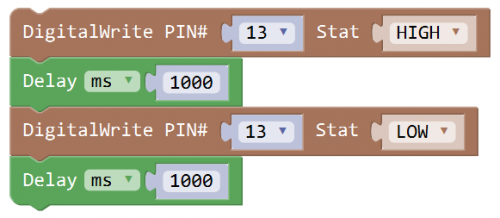
What you should see:
Drag the test code to Mixly window; remember to select the proper board and COM port.
Then compile and upload the code to your control board. Upload success message will appear on the bottom bar.
The UNO built-in LED (label “L”) will turn on for 1 second, and then turn off for 1 second, alternately and circularly.
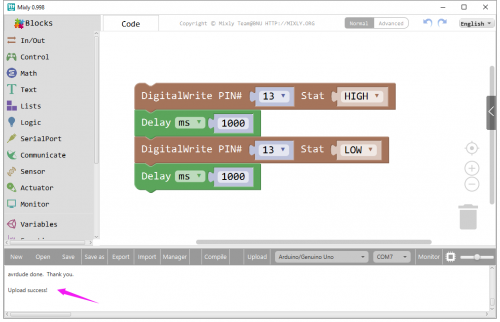
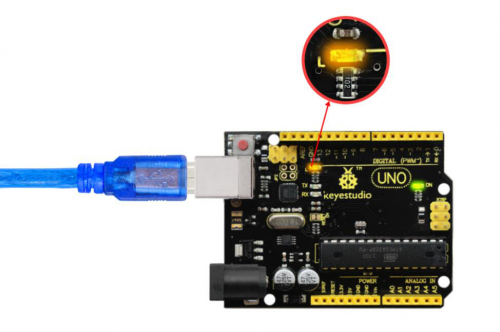
Project 2: LED Blink
Overview:
LED blink is one of the most basic experiments in learning programming.
This project we use keyestudio white LED module. You will learn first how to blink an LED.
There are three lead-out pins on the module, respectively negative pin(marked -), positive pin(marked +) and signal pin(marked S).
Separately connect the white LED module to the pin G, 5V and D3 of keyestudio motor drive shield V2 using three F-F jumper wires. Then stack the motor drive shield V2 onto the UNO control board.
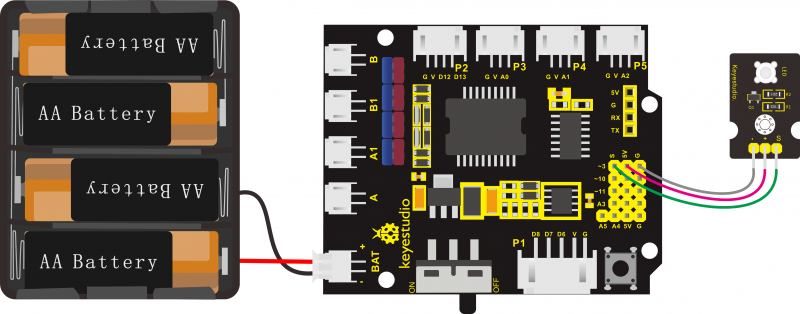
Done wiring, upload the test code to the board, so as to turn on an LED light.
Test Code:
Note: uploading the test code, DO NOT connect the Bluetooth module to motor drive shield. Otherwise, code upload fails.
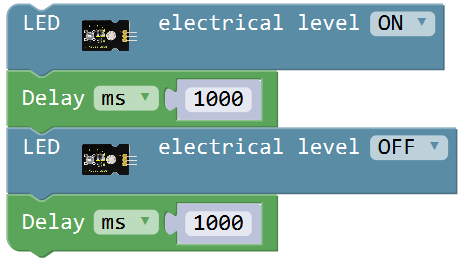
Result:
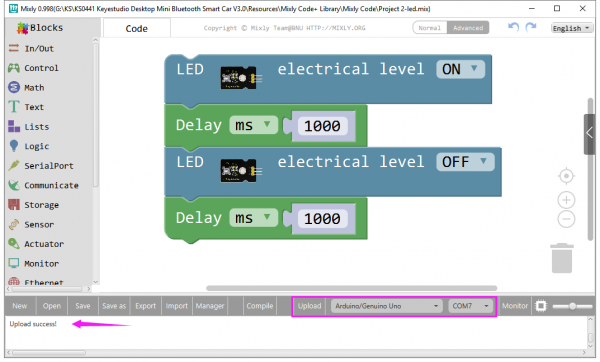
Done uploading the code, turn the slide switch ON.
You will see the LED module turn on for one second, then off gone second.
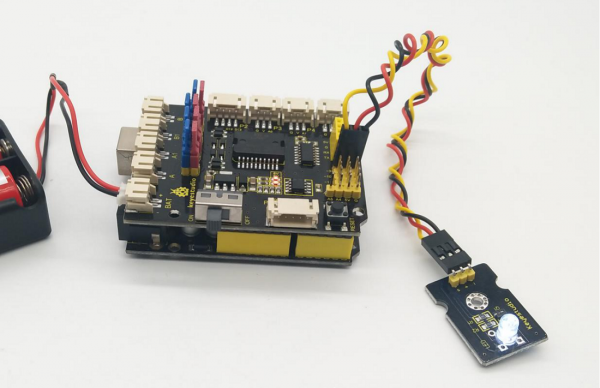
- Little Knowledge:
1.In the code, we’ve set the LED signal pin to D3 in the library; we can set the led signal pin without using library.
To make the same effect, you can use the block:
 or
or ![]()
2.What happens when you change the number in one or both of the delay(1000)

This delay period is in milliseconds, so if you want the LED to blink as low or fast, change the value, try 500 or 2000.
- Extension Practice:
Try making the LED blink without using library. Set the LED signal to D11, and turn on for 0.5 second; off for 0.2 second, alternately and circularly.
Project 3: Obstacles Detection
Overview:
The robot car kit is packed with 2 infrared obstacle detector sensors.
The infrared obstacle detector sensor is actually a distance-adjustable obstacle avoidance sensor designed for a wheeled robot.
It has a pair of infrared transmitting and receiving tubes. The transmitter emits an infrared rays of a certain frequency. When the detection direction encounters an obstacle (reflecting surface), the infrared rays are reflected back, and receiving tube will receive it. At this time, the indicator lights up. After processed by the circuit, the signal output terminal will output Digital signal.
You can rotate the potentiometer knob on the sensor to adjust the detection distance.
The effective distance is 2-40cm and the working voltage is 3.3V-5V.
TECH SPECS:
- Operating Voltage: DC 3.3-5V
- Detection Distance: 2-40cm
- Interface: 3PIN
- Output Signal: Digital signal
In this project, we read the signal level of obstacle detector sensor to judge whether detect obstacles or not.
When detects an obstacle, sensor’s signal pin outputs LOW (display 0); otherwise, output HIGH (display 1).
Show the result on the serial monitor, and control the external LED module turn ON/OFF.
Wiring Diagram:
Connect two infrared obstacle detector modules and an LED module to keyestudio motor drive shield V2. Then stack the motor drive shield onto UNO control board.
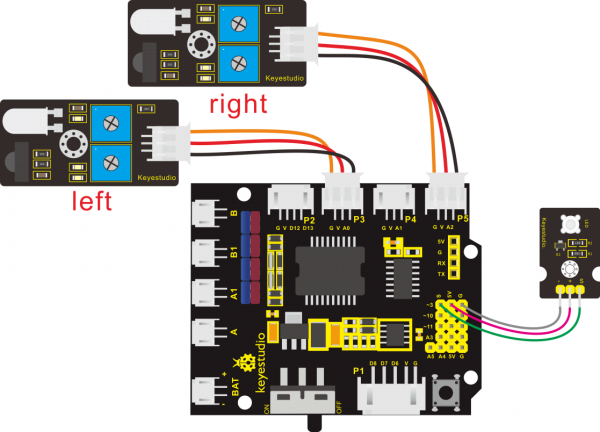
Special note:
You can turn the tirmpot on the obstacle detector sensor to adjust the inductive sensitivity.
Rotate the potentiometer near the infrared emitter to the end clockwise, then adjust the potentiometer near the infrared receiver to observe the Sled light, turn the Sled light off, and keep the critical point to be lit. The sensitivity is the best.
Result:
Done wiring, connect the UNO control board to computer’s USB port with USB cable to upload the code.
Code upload success, open the serial monitor, and set the baud rate to 9600. We can see the HIGH or LOW level of signal pin of left and right sensors. As shown below.
When any sensor detects obstacle (output 0), external LED module will turn on; otherwise, LED turns off.
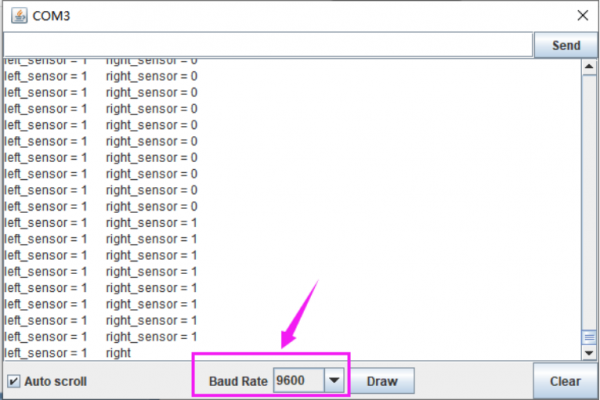
- Little Knowledge:
1.In the code,we use the library ![]() to read the HIGH/LOW of the left infrared avoiding sensor (A0); using the block
to read the HIGH/LOW of the left infrared avoiding sensor (A0); using the block ![]() also makes sense.
The signal pin of the right infrared avoiding sensor is A2.
also makes sense.
The signal pin of the right infrared avoiding sensor is A2.
2.![]() means the baud rate is set to 9600;
means the baud rate is set to 9600;
![]() Print the specified number, text or other value on serial monitor.
Print the specified number, text or other value on serial monitor.
![]() Print the specified number, text or other value on newline of monitor.
Print the specified number, text or other value on newline of monitor.
3.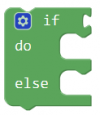 means that if condition 1 is satisfied, it's going to be A, otherwise it's going to be B.
means that if condition 1 is satisfied, it's going to be A, otherwise it's going to be B.
When using, you can find the if...do...statement block in the Mixly Control Block. Then click the gear icon on the block to drag out the else or else if block you need to use.
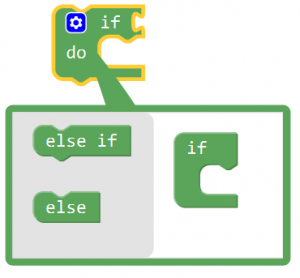
4.![]() This is a logical statement. It’s available as long as can satisfy any one of the two conditions.
This is a logical statement. It’s available as long as can satisfy any one of the two conditions.
- Extension Practice:
1.Change the test code without using the library, making the same function.
2.Set the two control pins of infrared avoiding sensor to turn on or off the LED.
Project 4: Playing Melody
Overview:
The keyestudio power amplifier module integrates an adjustable potentiometer, a passive buzzer speaker, an audio amplifier 8002B chip and 3pin header interface.
When testing, we can input square waves of different frequency at the signal pin to make passive buzzer speaker produce a sound.
We can turn the potentiometer to adjust the sound amplification, that is, to adjust the sound volume.
In this project, we will code the buzzer in power amplifier module to produce a tone. And if string a bunch of tones together, you’ve got music!
For connection, we connect the power amplifier module to the pin G, 5V, D11 of motor drive shield V2; then stack the motor drive shield onto UNO control board.
Wiring Diagram:
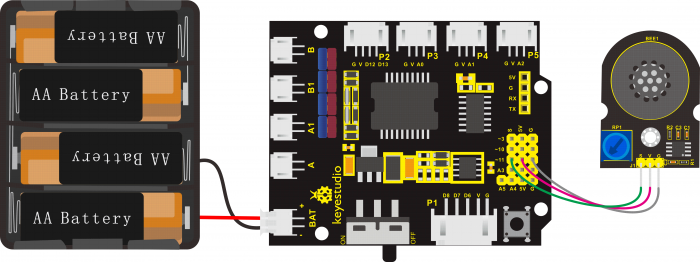
Test Code:
Code 1: play a tone
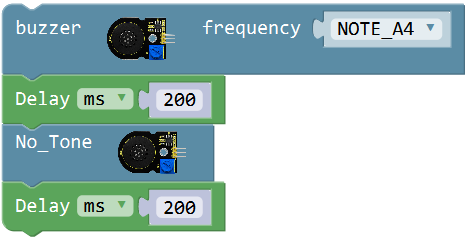
Code 2: do re mi fa so la si do
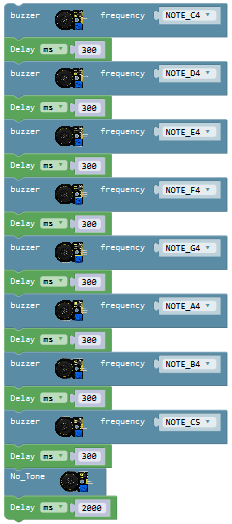
Code 3: Ode to Joy
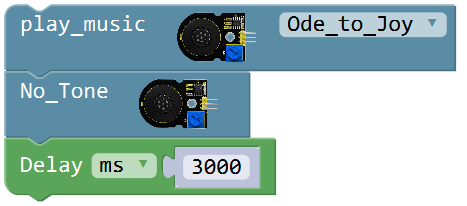
Result:
Done wiring, connect the UNO control board to computer’s USB port with USB cable to upload the code. Then turn the slide switch ON.
Upload code 1, buzzer will produce a tone of 440Hz for 0.2 second then off for 0.2 second, circularly.
Upload code 2, buzzer will play a tune “do re mi fa so la si do” circularly.
Upload code 3, buzzer will play a song Ode To Joy circularly.
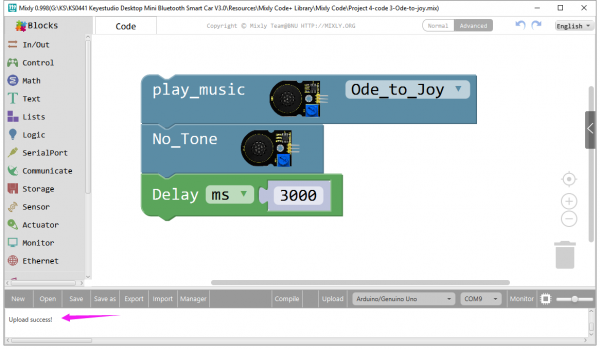
Remember that you can turn the potentiometer to adjust the sound volume if can’t hear the tone.
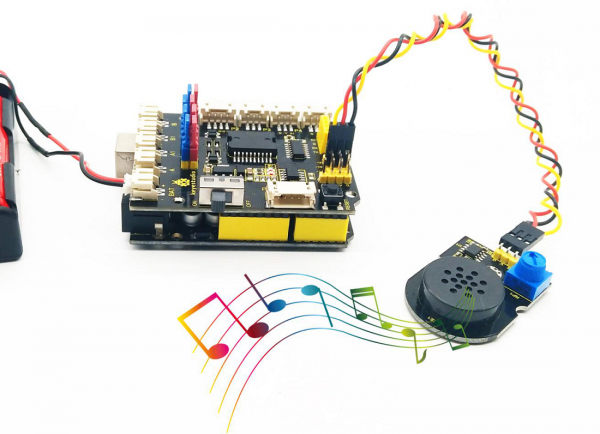
- Little Knowledge:
1.In the code 1, we use the library , the signal pin of passive buzzer module is connected to D11, with a frequency of 440Hz tone.
Note that you can click the Code on the Mixly window to check out the Arduino code.
, the signal pin of passive buzzer module is connected to D11, with a frequency of 440Hz tone.
Note that you can click the Code on the Mixly window to check out the Arduino code.
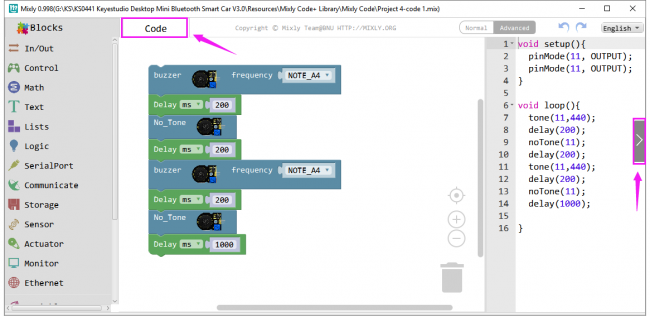
2.In the code 1 means the buzzer will make no tone.
means the buzzer will make no tone.
3.In the code 2 , we set the buzzer can play different tones of different frequencies.
, we set the buzzer can play different tones of different frequencies.
4.In the code 3 , means the buzzer will play a specific song. You can choose the tune Ode to Joy, or Birthday.
, means the buzzer will play a specific song. You can choose the tune Ode to Joy, or Birthday.
- Extension Practice:
1.For code 3, you can click to check out the corresponding language C; find out the tone of corresponding frequency and duration time, then refer to the code 2, try write into your own code.
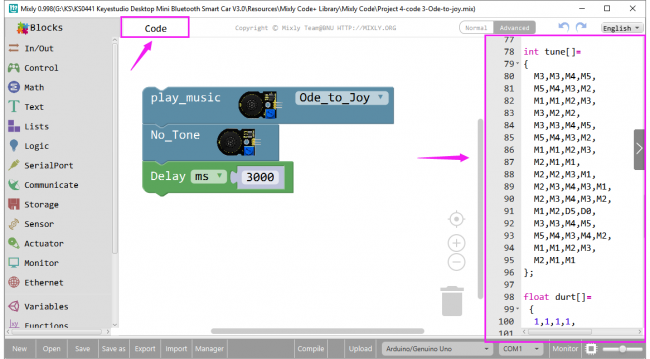
- Tips:
 set the frequency;
set the frequency;  set a period of time;
set a period of time;
The corresponding frequency of the first M3 is 658Hz; and the duration time is 300*1=300ms. The rest is in the same manner.
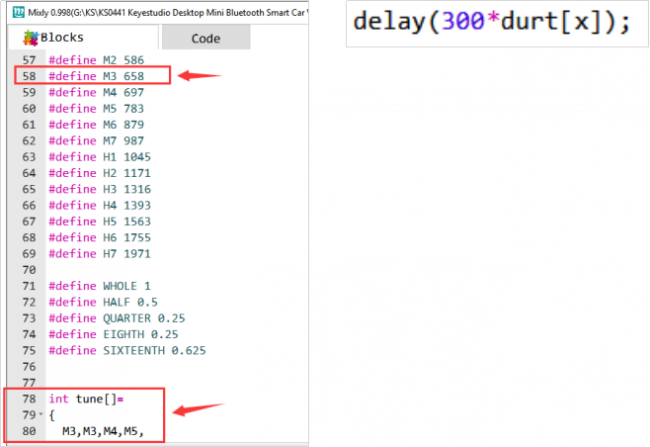
Project 5: Obstacles Alarm
Overview:
The ultrasonic module will emit the ultrasonic waves after trigger signal. When the ultrasonic waves encounter the object and are reflected back, the module outputs an echo signal, so it can determine the distance of object from the time difference between trigger signal and echo signal.
The ultrasonic module is commonly used in robot car DIY process. It can detect whether an obstacle ahead and we can measure the distance between ultrasonic sensor and obstacles by calculation.
When DIY smart car, we can use the measured distance data to program the robot car avoiding or following obstacles.
In this project, we are going to measure the distance between ultrasonic module and obstacles ahead, triggering the power amplifier module to make a sound.
When the measured distance between ultrasonic and obstacles ahead is less than 10cm, the speaker will produce a tone of 440Hz; otherwise, not sound.
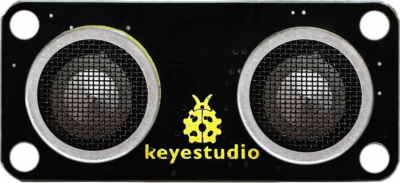
TECH SPECS:
- Operating Voltage: DC 5V
- Operating Current: 15mA
- Operating Frequency: 40khz
- Maximum Range: 2-3m
- Minimum Range: 2m
- Sensing Angle: 15 degrees
- Trigger Input Signal: 10µS TTL pulse
Wiring Diagram:
Connect Ultrasonic module and power amplifier module to keyestudio motor drive shield V2.
Then stack the motor drive shield onto UNO control board.
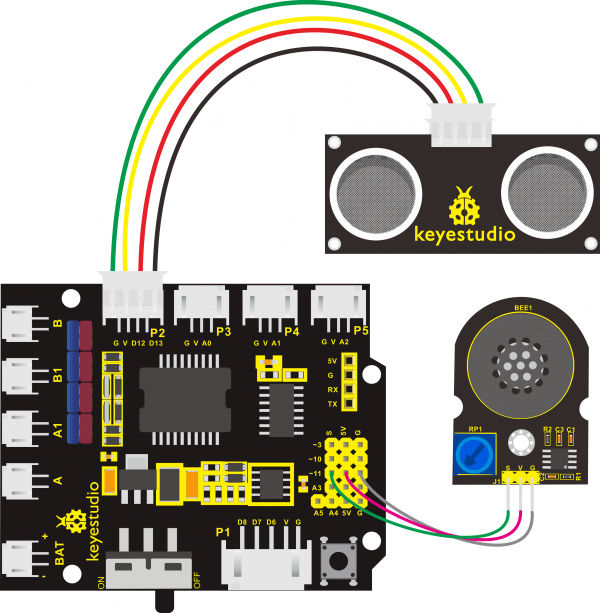
Result:
Done wiring, connect the UNO control board to computer’s USB port with USB cable to upload the code.
Code upload success, open the serial monitor, and set the baud rate to 9600. You can see the distance between ultrasonic and obstacle ahead, with a unit of cm.
When the measured distance between ultrasonic and obstacles ahead is less than 10cm, the speaker will produce a tone of 440Hz; otherwise, not sound.
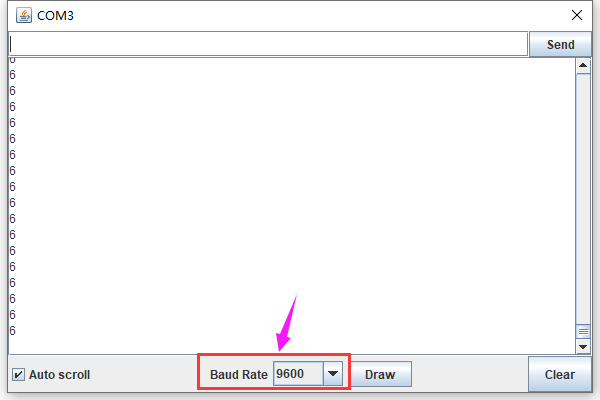
- Little Knowledge:
1.In the code, we use the  to measure the distance between ultrasonic sensor and obstacle ahead, with a unit of cm.
to measure the distance between ultrasonic sensor and obstacle ahead, with a unit of cm.
2.![]() means the baud rate is set to 9600;
means the baud rate is set to 9600;
![]() : print the distance value on the newline of monitor.
: print the distance value on the newline of monitor.
But if you use the block ![]() , it will not print the value on the newline; just print on the monitor. The difference between them is whether need to make line wrap.
, it will not print the value on the newline; just print on the monitor. The difference between them is whether need to make line wrap.
3.In the code also call the if...do... statement 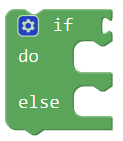 Refer to the detailed use in the project 3 please.
Refer to the detailed use in the project 3 please.
- Extension Practice:
1.You can reset the distance measured by ultrasonic sensor. Change the different distance value to make the buzzer play a tone of different frequency.
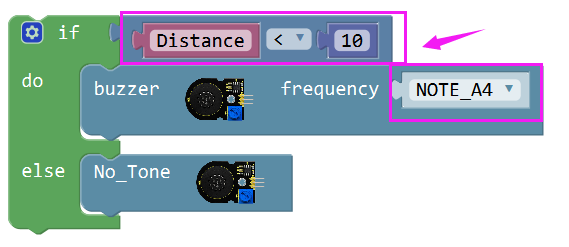
Project 6: Motor Driving and Speed Control
Overview:
There are many ways to drive the motor. Our robot uses the most commonly used L298P solution.
L298P is an excellent high-power motor driver IC produced by STMicroelectronics. It can directly drive DC motors, two-phase and four-phase stepping motors. The driving current up to 2A, and output terminal of motor adopts eight high-speed Schottky diodes as protection.
We have designed the motor driver shield V2 based on the L298P circuit.
The stackable design can make it be plugged directly into the Arduino, reducing the technical difficulty of using and driving the motor.
Direct stack the motor driver shield onto UNO R3 board, after the BAT is powered on, turn the Slide button ON, to supply the power for both keyestudio motor driver shield V2 and UNO R3 board.
For simple wiring, the motor driver shield comes with anti-reverse interfaces. When connecting the motor, power supply and sensor modules, you just need to plug in directly.
The Bluetooth interface on the motor driver shield is fully compatible with keyestudio HM-10 Bluetooth module. When connecting, just plug HM-10 Bluetooth module into the corresponding interface.
At the same time, the motor drive shield has brought out extra digital and analog ports in 2.54mm pin headers, so that you can continue to add other sensors for experiments extension.
The motor drive shield can access to 4 DC motors, defaulted by jumper connection. The motor connector A and A1, connector B and B1 are separately in parallel.
The 8 jumpers can be applied to control the turning direction of 4 motors.
For instance, if change the 2 jumpers near the motor A connector from horizontal connection to vertical connection, the turning direction of motor A is opposite to the original rotation direction.
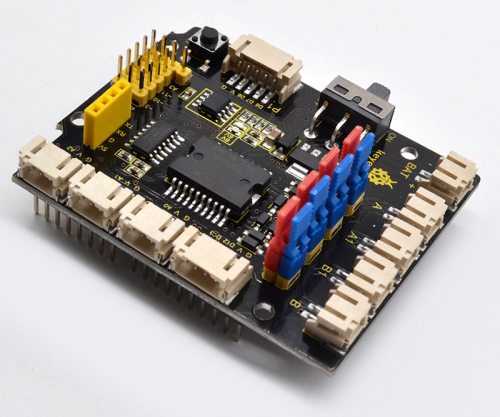
Specifications:
- 1)Logic part input voltage: DC5V
- 2)Driving part input voltage (limit): DC 6-18V
- 3)Driving part input voltage (recommended): DC 7-12V
- 4)Logic part working current: <36mA
- 5)Driving part working current: <2A
- 6)Maximum power dissipation: 25W (T=75℃)
- 7)Working temperature: -25℃~+130℃
Wiring Diagram:
Connect two motors to keyestudio motor drive shield V2; stack the motor drive shield onto UNO control board.
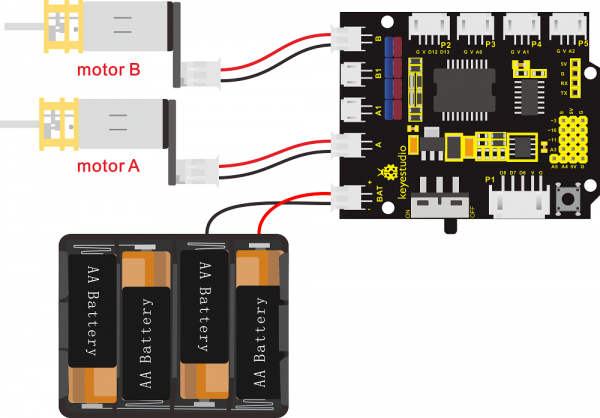
Driving Motor
According to the wiring diagram, default the jumper connection method.
Follow the table below to drive the 2 motors rotate by Digital, PWM pins, so as to control the robot car run.
The PWM value is in the range of 0-255. The greater the value set, the faster the motors rotate.
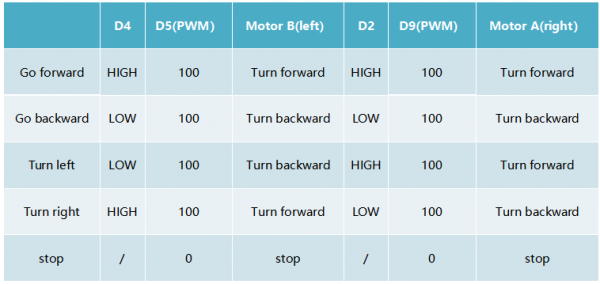
Result:
Done wiring, connect the UNO control board to computer’s USB port with USB cable to upload the code.
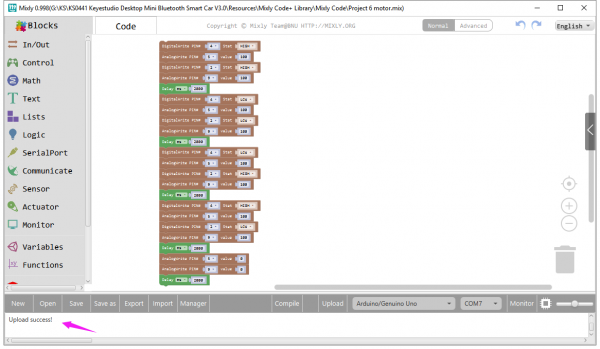
Upload success, turn the Slide switch ON. The 2 motors act like the smart car to turn forward for 2 seconds, backward for 2 seconds, and then turn left for 2 seconds, turn right for 2 seconds, stop for 2 seconds, alternately and circularly.
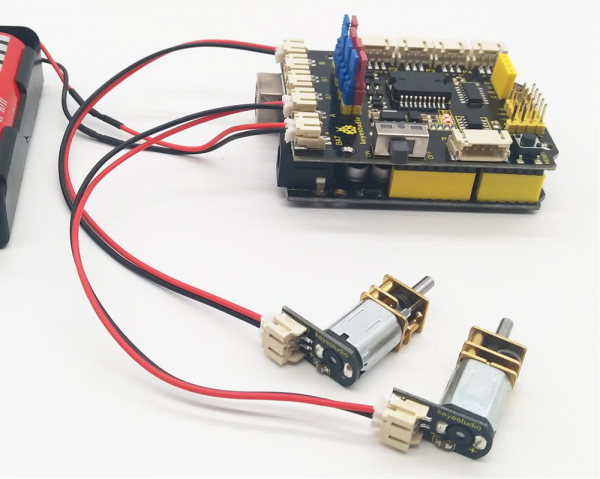
- Little Knowledge:
1.The code logic is completely based on the motor driving reference table. Check it out.
2.The PWM value is in the range of 0-255. The greater the value set, the faster the motors rotate. Base on that, you can set the speed as you like.
- Extension Practice:
1.Based on the logic table, try to reset a new moving track for your smart car.
Project 7: Library Driving Motor
Overview:
There are many ways to drive the motor. We have learned how to control the 2 motors in the previous section, so as to drive the smart car run. It is troublesome to control the smart car via control port. For this, we specially create the library to drive the robot car more simple and easier.
When setting, the PWM value is in the range of 0-255. The greater the value set, the faster the motors rotate.
Result:
Done wiring, connect the UNO control board to computer’s USB port with USB cable to upload the code.
Upload success, turn the Slide switch ON. The 2 motors act like smart car to turn forward for 2 seconds, backward for 2 seconds, and then turn left for 2 seconds, turn right for 2 seconds, stop for 2 seconds, circularly.
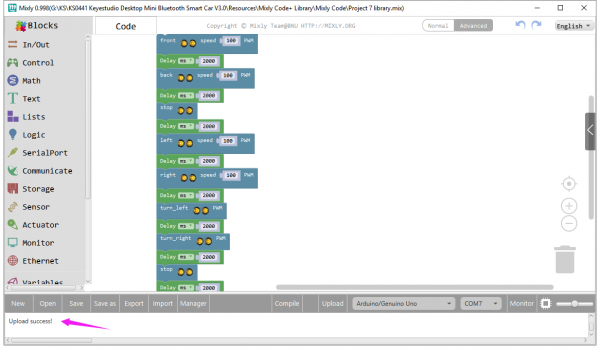
- Little Knowledge:
1.The code using library to set the car’s motion state, easy and simple, shortening the code length.
2.The control logic is the same as project 6-motor driving. We can click to check out the corresponding language C of motor mixly code.
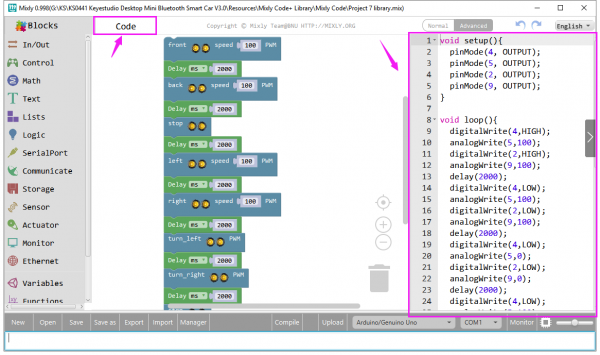
- Extension Practice:
1.Based on the logic table, try to reset a new moving track for your smart car.
Project 8: Line Tracking Sensor
Overview:
The tracking sensor is actually an infrared sensor. The component used here is the TCRT5000 infrared tube. Its working principle is to use the different reflectivity of infrared light to the color, then convert the strength of the reflected signal into a current signal.
During the process of detection, black is active at HIGH level, but white is active at LOW. The detection height is 0-3 cm.
For keyestudio 3-channel line tracking module, we have integrated 3 sets of TCRT5000 infrared tube on a single board. It is more convenient for wiring and control.
By rotating the adjustable potentiometer on the sensor, it can adjust the detection sensitivity of the sensor.
Special note: before testing, turn the potentiometer on the sensor to adjust the detection sensitivity.
When adjust the LED front the trimpot at the threshold between ON and OFF, the sensitivity is the best.
TECH SPECS:
- Operating Voltage: 3.3-5V (DC)
- Interface: 5PIN
- Output Signal: Digital signal
- Detection Height: 0-3 cm
Wiring Diagram:
Next let’s do a simple test for this tracking module. The connection diagram is shown as below.
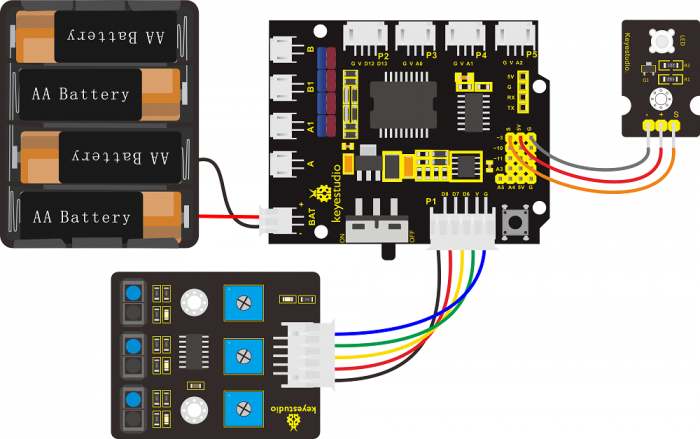
Result:
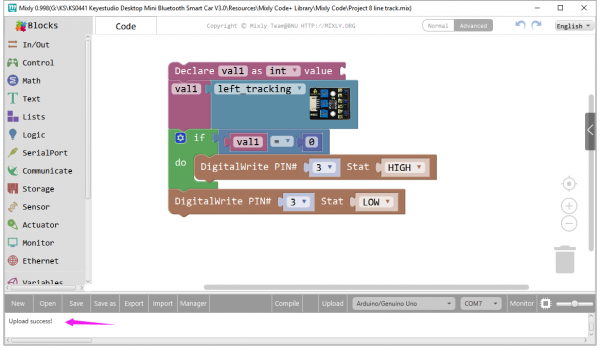
Done wiring, connect the UNO control board to computer’s USB port with USB cable to upload the code.
Upload success, turn the Slide switch ON.
When the left TCRT5000 infrared tube detects a white line, LED module lights; detecting a black line, LED turns off.
In a similar way, we use other 2-way TCRT5000 infrared tubes to detect the black-white line.
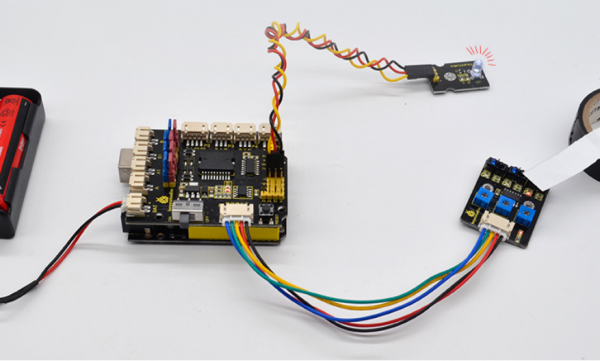
- Little Knowledge:
1.In the code, we use the library  to read the HIGH/LOW of the left sensor (D6); using the block
to read the HIGH/LOW of the left sensor (D6); using the block  also makes sense.
also makes sense.
The signal pin of the middle sensor is D7; the signal pin of the right sensor is D8.
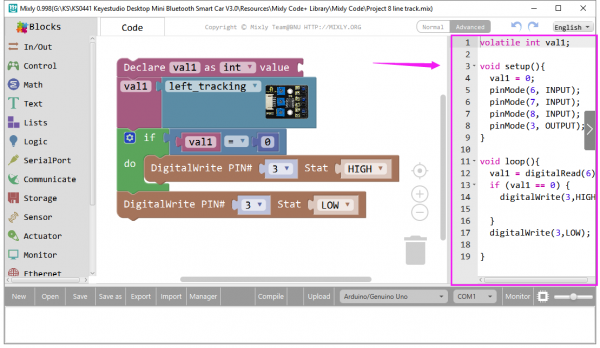
2. means that if condition 1 is satisfied, it's going to be A, otherwise it's going to be B.
means that if condition 1 is satisfied, it's going to be A, otherwise it's going to be B.
When using, you can find the if...do...statement block in the Mixly Control Block. Then click the gear icon on the block to drag out the else or else if block you need to use.

- Extension Practice:
1.Change the test code without using the library, making the same result.
2.Set the 3 control pins of line tracking sensor to turn on or off 3 LEDS.
Project 9: Infrared Receiver
- IR Remote Control:
There is no doubt that infrared remote control is commonly seen in our daily life. It's hard to imagine our world without it.
An infrared remote control can be used to control a wide range of home appliances such as television, audio, video recorders and satellite signal receivers.
Well, in the following let’s get a better understanding of the infrared remote control.
Infrared remote control is composed of infrared transmitting and infrared receiving systems. That is, consist of an infrared remote control, an infrared receiver module and a microcontroller that can decode. You can refer to the figure below.

The 38K infrared carrier signal transmitted by an infrared remote controller is encoded by an encoding chip inside the remote controller. It is composed of a pilot code, user code, data code, and data inversion code.
The time interval between pulses is used to distinguish whether it is a signal 0 or 1. (when the ratio of high level to low level is about 1:1, considered as signal 0.) And the encoding is just well composed of signal 0 and 1.
The user code of the same button on remote controller is unchanged. Using difference data distinguish the key pressed on the remote control.
When press down a button on the remote control, it will send out an infrared carrier signal. And when infrared receiver receives that signal, its program will decode the carrier signal, and through different data codes, thus can judge which key is pressed.
The microcontroller is decoded by an received signal 0 or 1 to determine which key is pressed by the remote control.
- IR Receiver Module:
As for an infrared receiver module, it is mainly composed of an infrared receiving head. This device integrates with reception, amplification and demodulation. Its internal IC has been demodulated, outputting Digital signal. Suitable for IR remote control and infrared data transmission.
The infrared receiver module has only three pins (Signal, VCC, GND), very convenient to communicate with Arduino and other microcontrollers.
Parameters of IR Receiver:
- 1)Operating Voltage: 3.3-5V(DC)
- 2)Interface: 3PIN
- 3)Output Signal: Digital signal
- 4)Receiving Angle: 90 degrees
- 5)Frequency: 38khz
- 6)Receiving Distance: 18m
Hookup Guide:
Let’s connect the infrared receiver to motor drive shield to make a simple test.
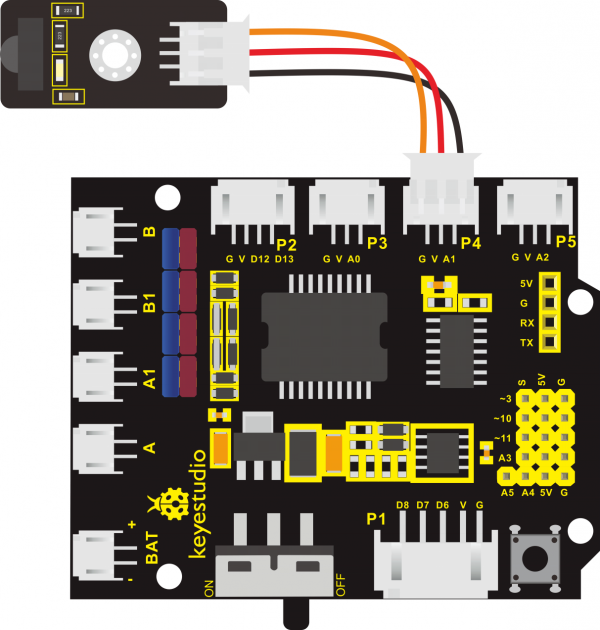
Test Result:
Code upload success, open the serial monitor, and set the baud rate to 9600.
Press your remote control, aimed at the infrared receiver, to send the signal, and you will see the encoding of each button on the remote control.
Note if press the control button too long, easily appear unreadable code. Shown as below figure.
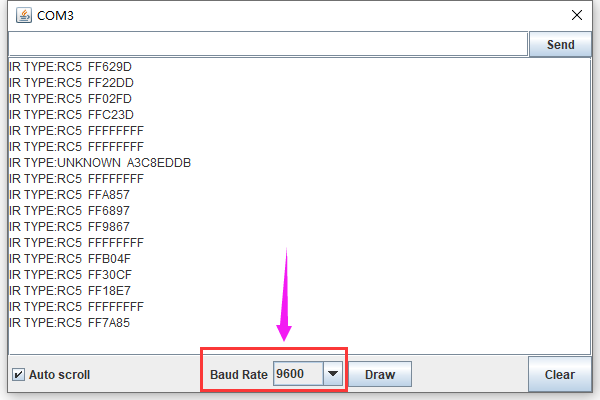
Below we have listed out each button value of keyestudio remote control. So you can keep it for reference.
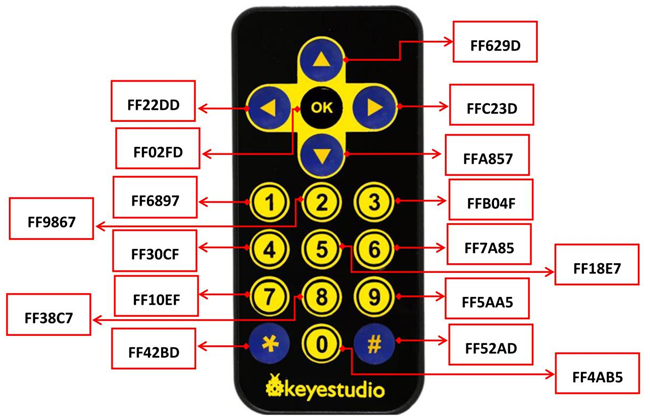
Little Knowledge:
1.In the code, we direct use the library ; the signal pin of IR receiver module is A1; the IR receiver receives an infrared signal and outputs 16-bit encoding, printing out on serial monitor (baud rate 9600).
2.We can test out the 16-bit encoding of each button on the infrared remote control by source code. Or you can see the button encoding chart shown above.
; the signal pin of IR receiver module is A1; the IR receiver receives an infrared signal and outputs 16-bit encoding, printing out on serial monitor (baud rate 9600).
2.We can test out the 16-bit encoding of each button on the infrared remote control by source code. Or you can see the button encoding chart shown above.
Extension Practice:
1.Turning on or off several LED modules by infrared remote control.
2.Driving the 2 motors’ turning direction and speed by infrared remote control.
(refer to project 6- motor driving)
Combine infrared receiver and motors driving knowledge to build an infrared remote control car.
Assembly Steps for Desktop Car
Follow the assembly steps below to build your own robot.
1) Bottom motor parts
You should mount two motors on the Acrylic bottom board.
Prepare the components as follows:
- M2 Nut *4
- White N20 motor holder *2
- 12FN20 motor connector *2
- M2*10MM round-head screw *4
- Acrylic bottom board *1
First place four M2 Nuts inside the holes of white N20 motor holders.
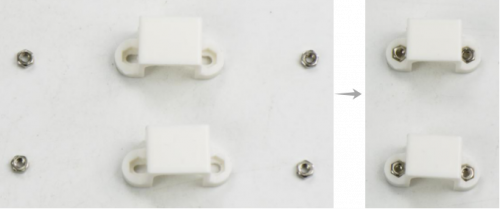
Note: the Acrylic plate is marked with A, B for the two motors. Mount the motor A to label A on the Acrylic plate; motor B to Acrylic position B.
Then mount the white N20 holders onto the motors.
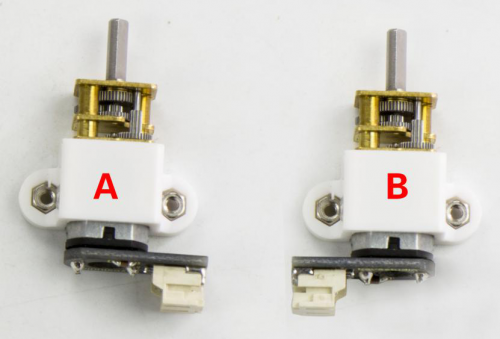
Fix these two 12FN20 motor connectors on the Acrylic bottom plate with four M2*10MM round-head screws.
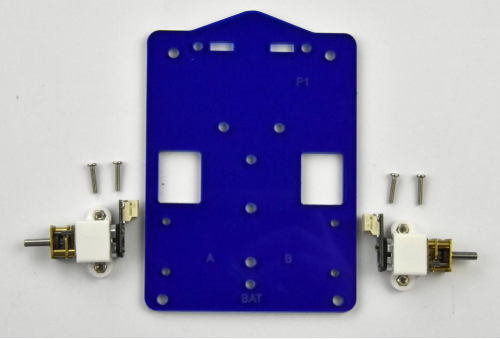
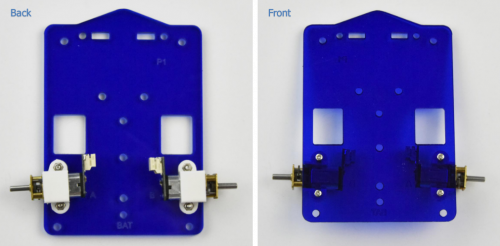
2) Battery case
You can choose the 18650 2-cell battery case or 4-cell AA battery case.Mount the battery case on the acrylic bottom board.
Here we install the 4-cell AA battery case for the smart car. You should first get some parts below:
- 4-cell Battery case*1
- M3*8MM flat-head screws *2
- M3 Nut *2
Fix the battery case on the top of Acrylic board using two M3*8MM flat-head screws and two M3 Nuts.
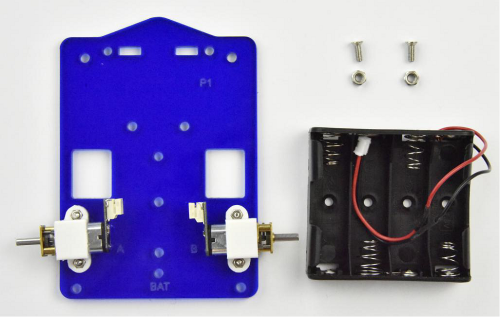
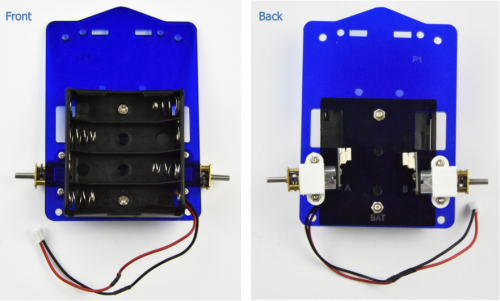
3) Tracking sensor and wheels
Assemble the line tracking sensor and connect the wire:
- JST-PH2.0MM-2P 24AWG red-black wire 160mm *2
- JST-PH2.0MM-5P blue-green-yellow-red-black connector wire 15CM *1
- M3*5+6MM single-pass copper pillars *2
- M3*6MM round-head screws *2
- M3 Nut *2
- Wheel *2
- Line tracking sensor *1
Connect 2 pieces of JST-PH2.0MM-2P red-black wire 160mm to the 12FN20 motor connectors. Connect two wheels to the motor spin.
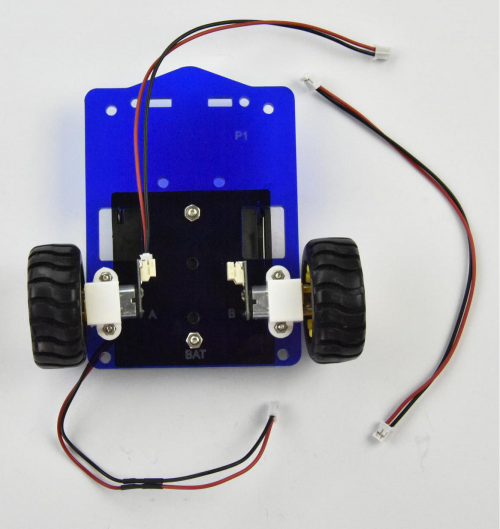
Insert two M3*5+6MM single-pass copper pillars into the holes on the line tracking sensor, and tighten two M3 Nuts on the copper pillars. Shown below.
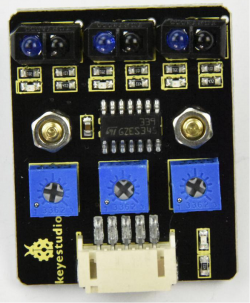
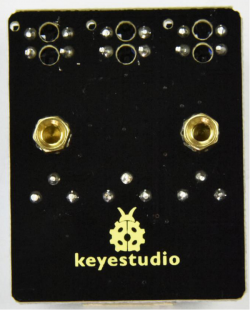
After that, mount the line tracking sensor on the Acrylic board with two M3*6MM round-head screws.
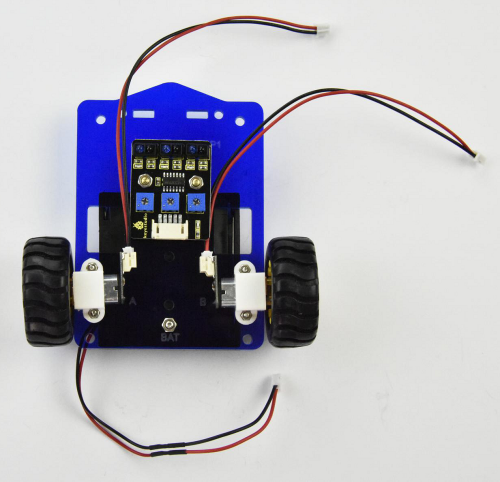
Connect a JST-PH2.0MM-5P 24AWG blue-green-yellow-red-black connector wire 15CM to the connector of tracking sensor. Shown below.
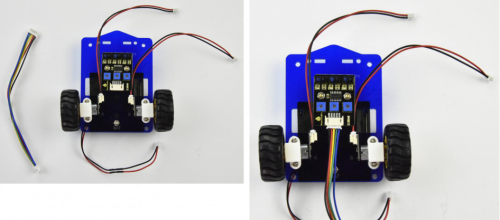
Completed the above assembly, let's install the caster for this small car.
- W420 ball caster wheel *1
- M3*6MM round-head screws *6
- M3 Nut *2
- M3*8+6MM single-pass copper pillar *2
- M3*40MM dual-pass copper pillar *4
Screw the W420 ball caster wheel on the Acrylic bottom board with two M3*6MM round-head screws, two M3 Nuts, two M3*8+6MM single-pass copper pillars.
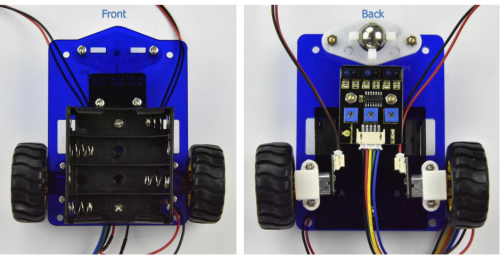
Screw four M3*40MM dual-pass copper pillars on the 4 corner holes on acrylic bottom board with four M3*6MM round-head screws.
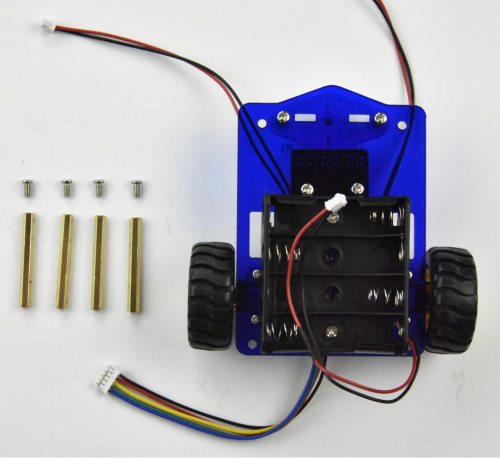
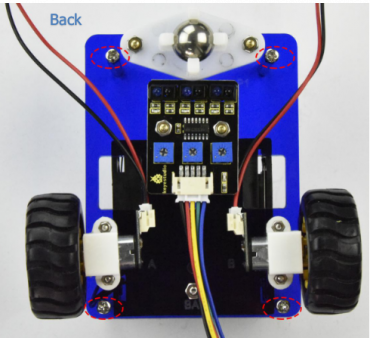
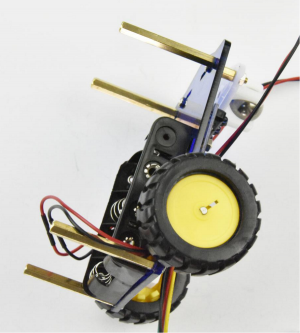
4) Ultrasonic module
Now should install the particular eyes for this smart car, i.e. Ultrasonic module.
- Ultrasonic module *1
- M3*10MM round-head screw *4
- M3 Nut *4
- Ultrasonic acrylic board *1
- JST-PH2.0MM-4P connector wire 8CM *1
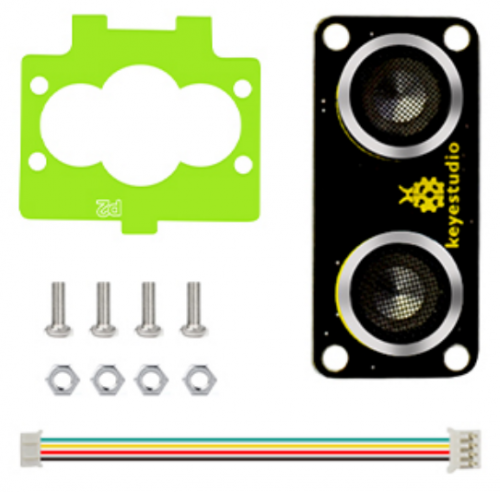
Look at the figure below, fix the ultrasonic module on the acrylic board with four M3*10MM round-head screws and four M3 Nuts.
Then connect the JST-PH2.0MM-4P connector wire to ultrasonic module.
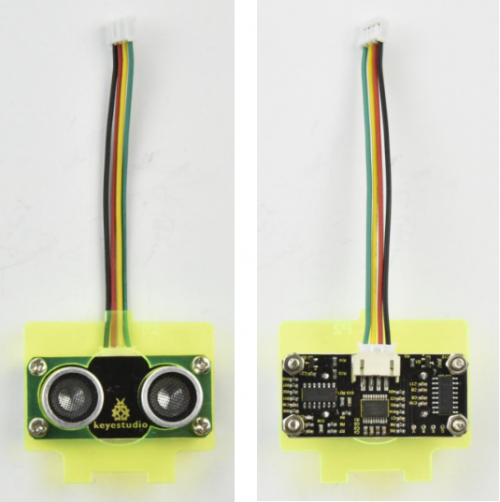
5) Acrylic top board
Fix other sensors on the Acrylic top board. Prepare parts as follows:
- Acrylic top board *1
- Obstacle detector sensor *2
- IR receiver sensor *1
- Keyestudio power amplifier module *1
- M3*10MM round-head screw *4
- M3 Nut *8
- M3*8+6MM single-pass copper pillar*4
- JST-PH2.0MM-3P yellow-red-black wire 8CM *3
- 3pin F-F jumper wire *1
Tighten four M3*8+6MM single-pass copper pillars on the acrylic top board with four M3 Nuts.
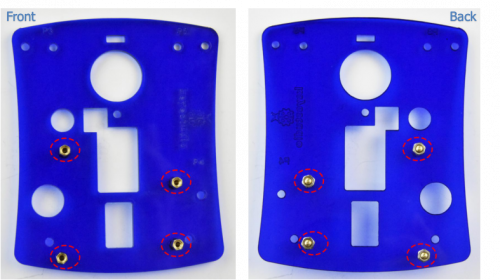
Separately mount two obstacle detector sensors and an IR receiver sensor on Acrylic top plate with three M3*10MM screws and three M3 Nuts.
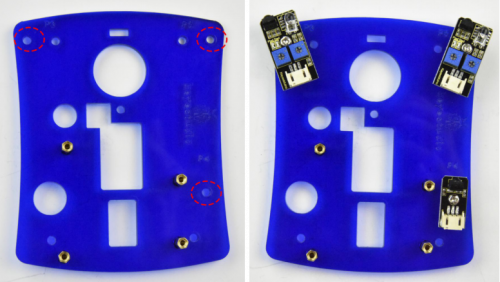
Mount keyestudio power amplifier module on Acrylic top plate with a M3*10MM screw and a M3 Nut.
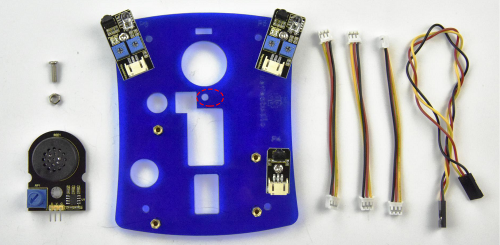
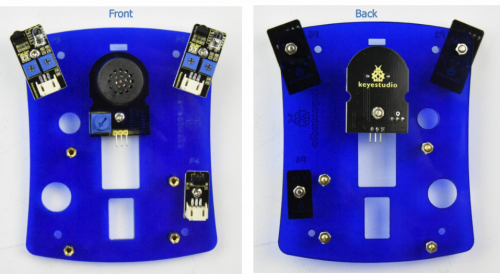
Connect the wire to the keyestudio power amplifier module, obstacle detector sensors and an IR receiver sensor.
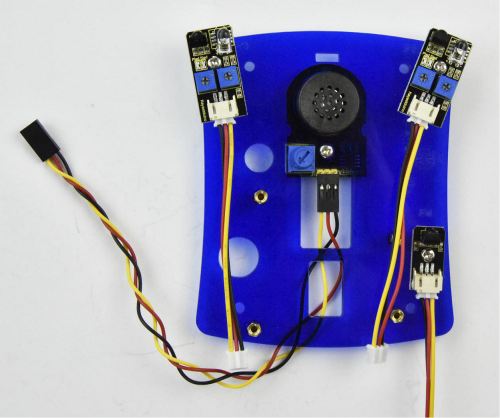
6) Complete Car
Till now, the smart car is almost installed well.
Assemble all the finished parts and install the control board as follows:
- UNO R3 main board *1
- Motor drive shield *1
- Bluetooth module*1
- Jumpers cap *8
- M3*6MM round-head screw *8
Firstly, insert the ultrasonic module into the two holes of Acrylic bottom board.
Then, screw the Acrylic top board to the copper pillars mounted on Acrylic bottom plate with four M3*6MM round-head screws.
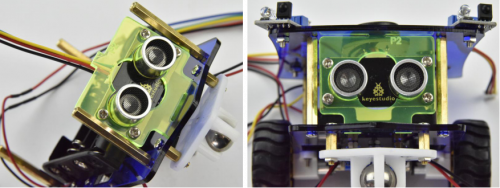
After that, mount the UNO R3 main board onto the Acrylic top board with four M3*6MM round-head screws.
And stack the motor drive shield onto UNO R3 board.
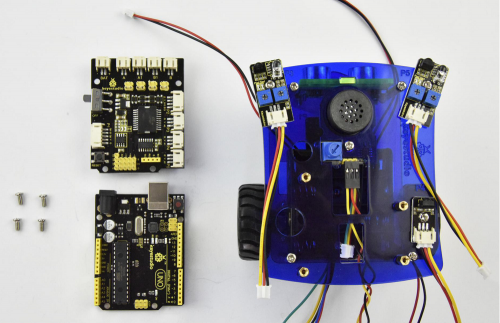
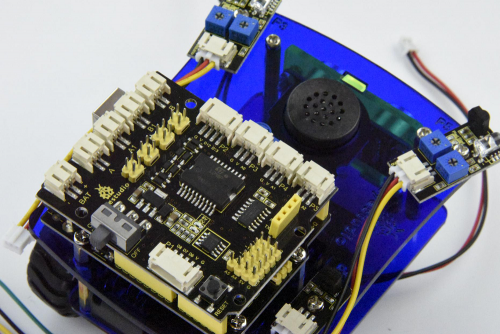
Finally insert the 8 jumpers and HM-10 Bluetooth module into the motor drive shield.
(8 jumpers direction are by default; changing the jumper direction will change the motor turning direction)
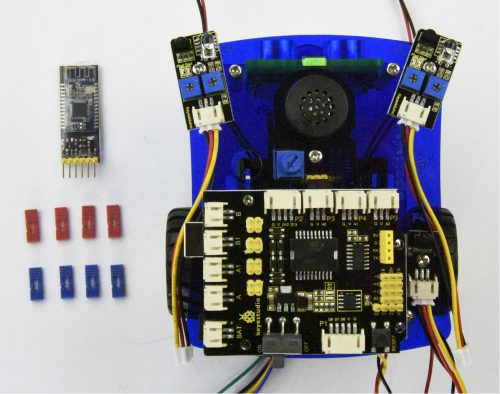
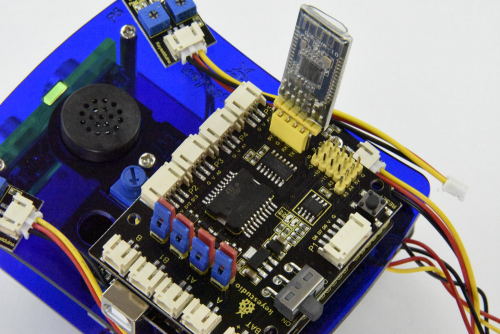
Up to now, you have finished the hardware installation of the smart car. Congrats!
For wiring, you can connect all the wires according to the corresponding silk-screen on the board.
Connection diagram:
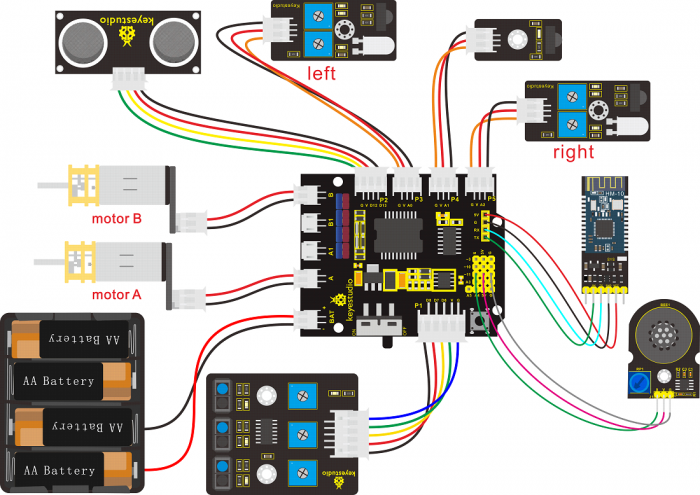
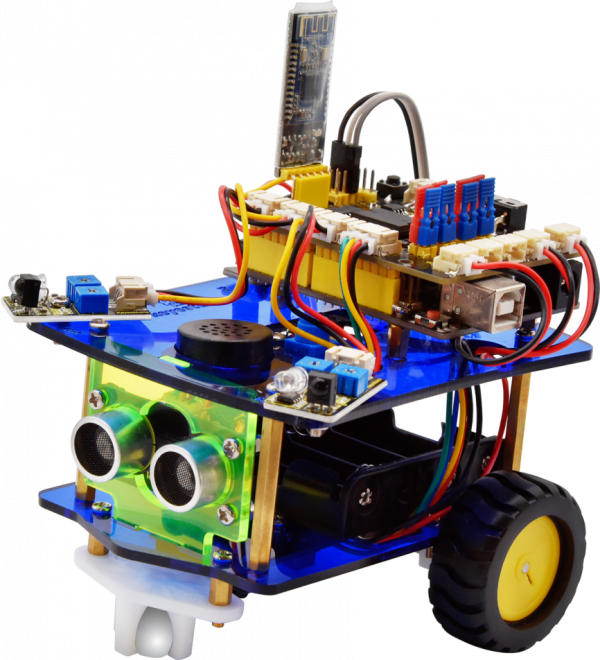
The Desktop car is now completing installation.
Follow the detailed project instructions to build your own robot with various functions.
Project 10: Following Robot
Circuit Design:
In the above sections we already introduced the motor drive shield, sensor, module, motors and other elements.
According to the project 3/5/7 -- obstacle detection, obstacle alarm, and library driving motor,
we’re now ready to give the robot capability - Object Following!
In the project, we make the robot measure whether exist obstacles at both sides with obstacle detector sensors. Measure the distance between obstacle and robot, and then use the measured data to rotate the two motors, so as to control the robot car run.
Below is a specific logic table of following robot for reference:
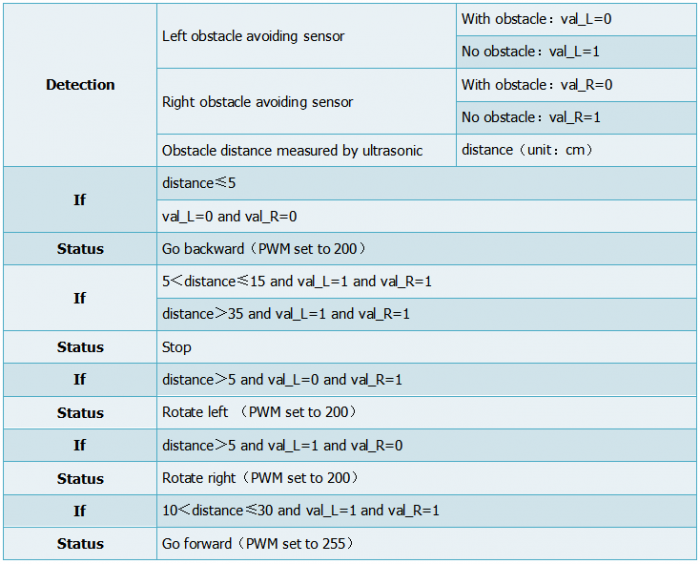
Build Following Robot:
Based on the designed circuit, we are going to build a following robot car.
Check the circuit diagram and test code below.
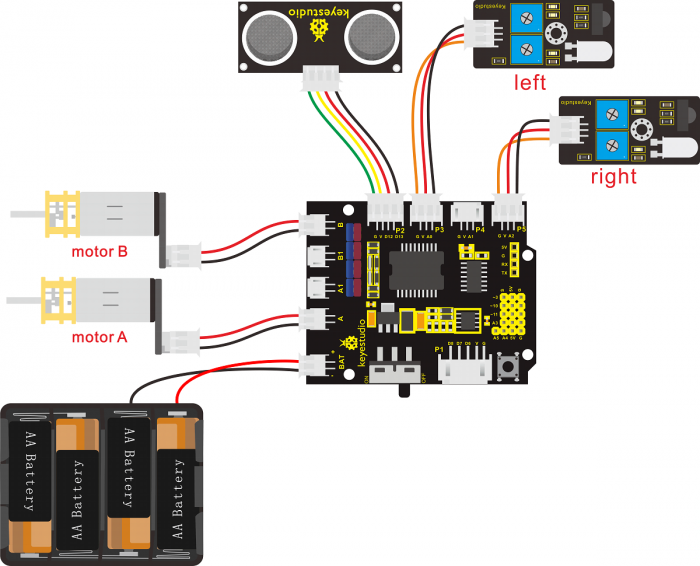
Test Code:
Can’t connect the Bluetooth module when upload the code, otherwise, code upload fails.
You should upload the code success, then plug in the Bluetooth module.
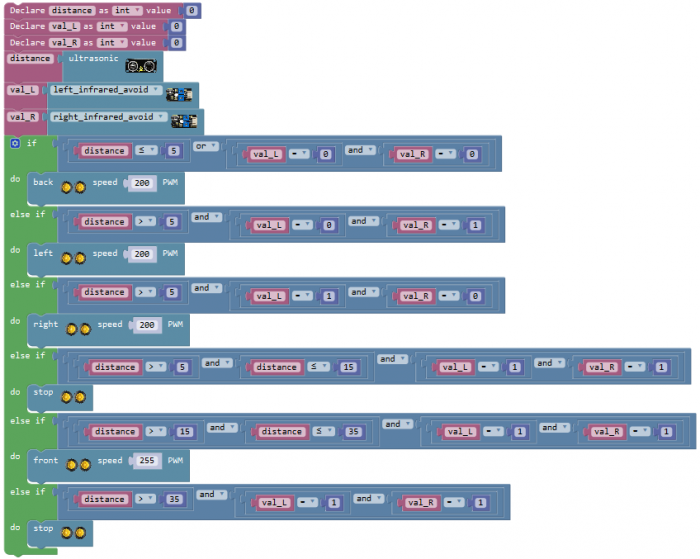
Result:
Stack the motor drive shield onto UNO board. Connect the UNO control board to computer’s USB port with USB cable to upload the code.
Upload success and turn the slide switch to ON position. The robot will follow the front object to move.
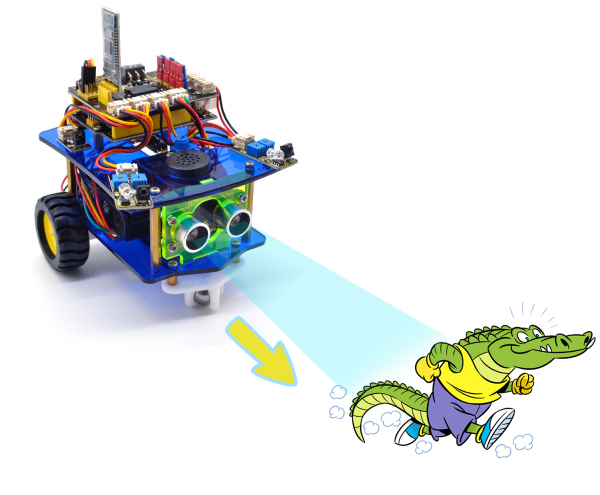
Project 11: Obstacle Avoiding Robot
Circuit Design:
We’re now ready to give the robot another capability - Obstacle Avoiding!
It is pretty simple. Just keep the same components and connection method as following robot, but need to change the code.
Below is a specific logic table of Obstacle Avoiding robot for reference:
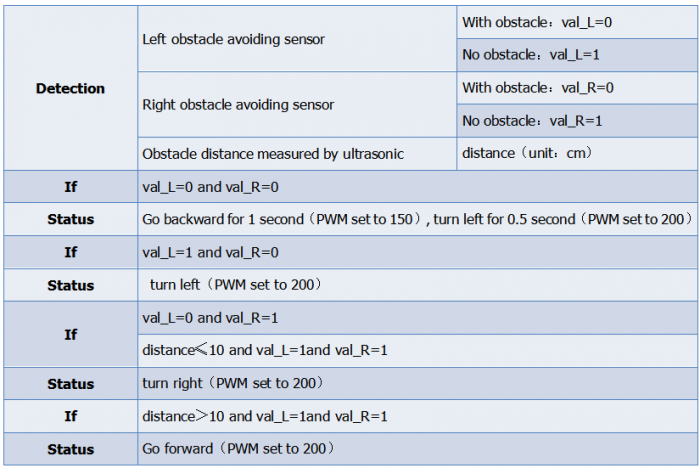
Build Obstacle Avoiding Robot:
Based on the designed circuit, we are going to build an obstacle avoiding robot car.
Check the circuit diagram and test code below.
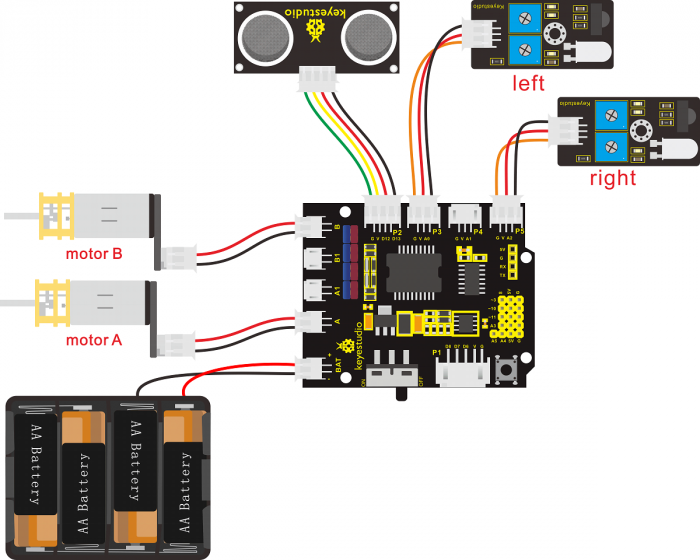
Test Code:
Can’t connect the Bluetooth module when upload the code, otherwise, code upload fails.
You should upload the code success, then plug in the Bluetooth module.
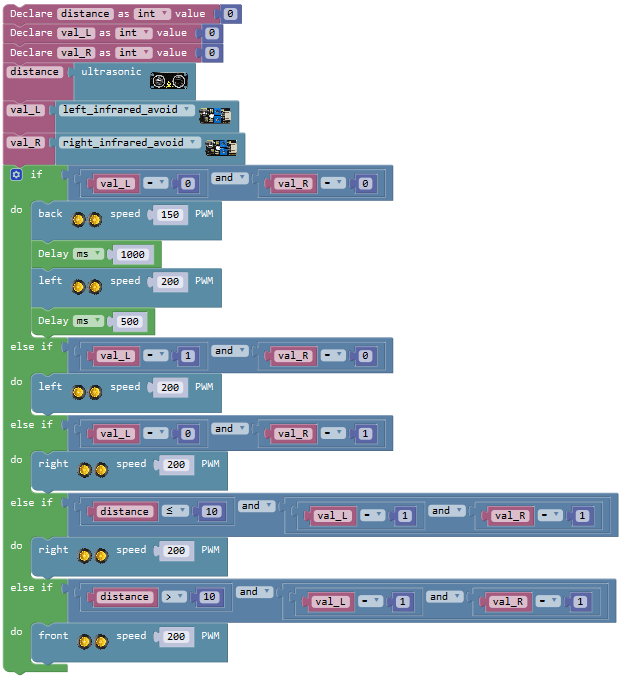
Result:
Upload success and turn the slide switch to ON position.
The robot can automatically avoid the front obstacle to run.
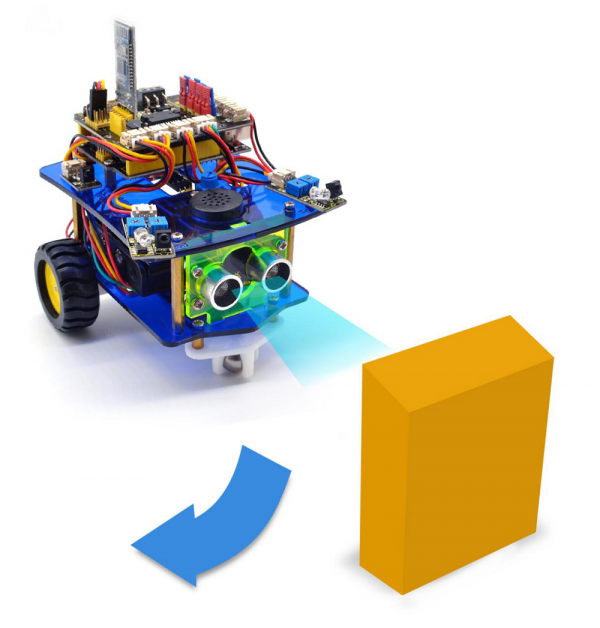
Project 12: Line Tracking Robot
Circuit Design:
In the above sections we already introduced the motor drive shield, sensor, module, motors and other elements.
According to the project 7/8 -- library driving motor, line tracking sensor,
we’re now ready to give the robot capability - Line Tracking!
In the project, we make the robot detect black line at the car bottom with line tracking sensor. Then control the 2 motors rotate by measured result, so as to drive the robot track black line.
Below is a specific logic table of line tracking robot for reference:
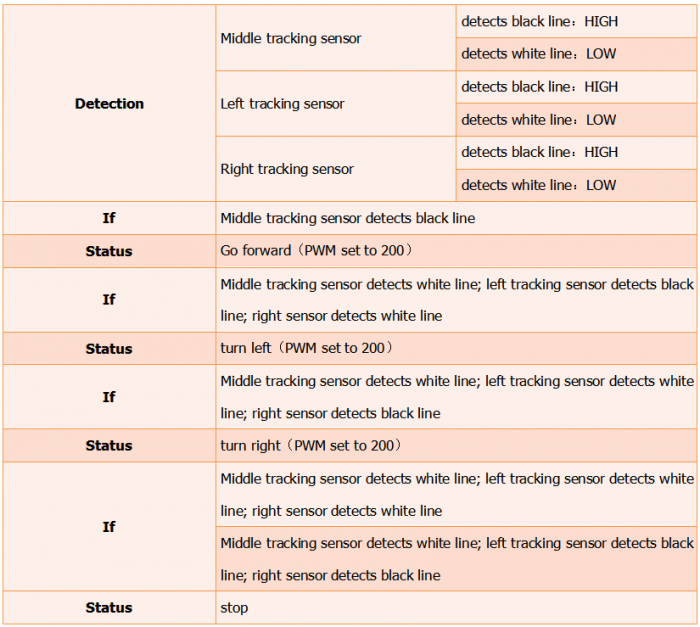
Build Line Tracking Robot:
Based on the designed circuit, we are going to build a line tracking robot car.
Check the circuit diagram and test code below.
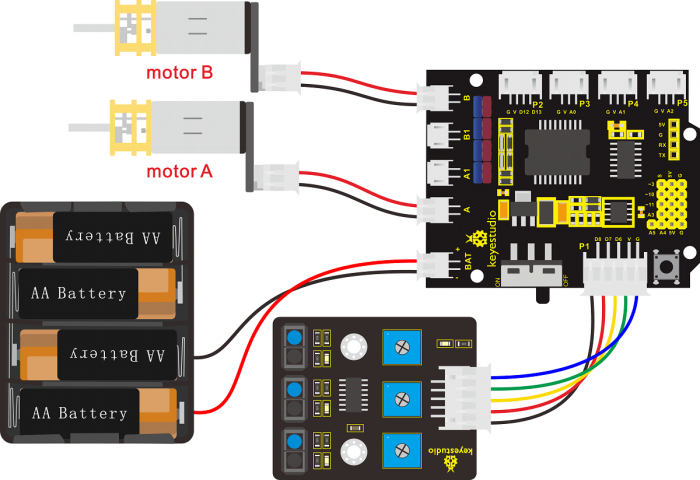
Test Code:
Can’t connect the Bluetooth module when upload the code, otherwise, code upload fails.
You should upload the code success, then plug in the Bluetooth module.
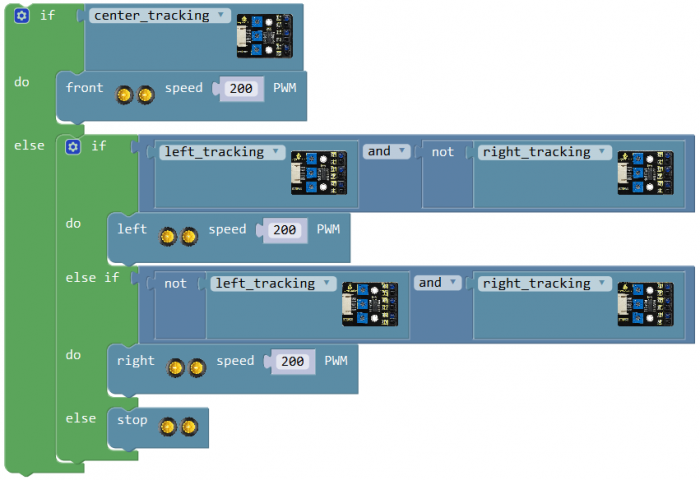
Result:
Upload success and turn the slide switch to ON position.
The robot can automatically track black line.
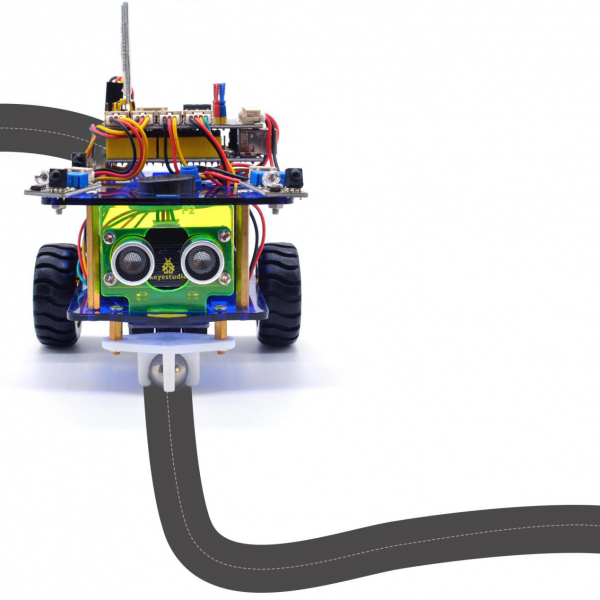
Project 13: IR Remote Control Robot
Circuit Design:
In the above sections we’ve already introduced the motor drive shield, sensor, module, motors and other elements.
According to the project 7/9 -- library driving motor, infrared receiver,
we’re now ready to give the robot capability - IR Remote Control!
In the infrared receiver section, we have listed out each button encoding of remote control.
In this project code, we can set the button value to control the robot status.
Below is a specific logic table of IR Remote Control robot for reference:
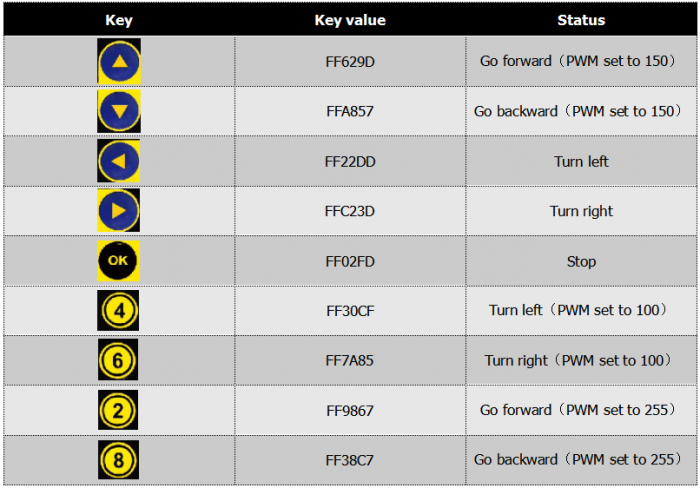
Build IR Remote Control Robot:
Based on the designed circuit, we are going to build an IR remote control car.
Check the circuit diagram and test code below.
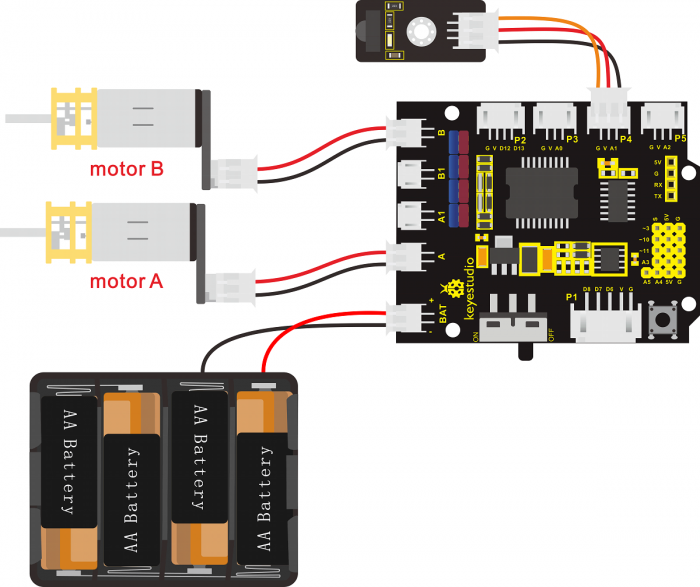
Test Code:
Can’t connect the Bluetooth module when upload the code, otherwise, code upload fails.
You should upload the code success, then plug in the Bluetooth module.
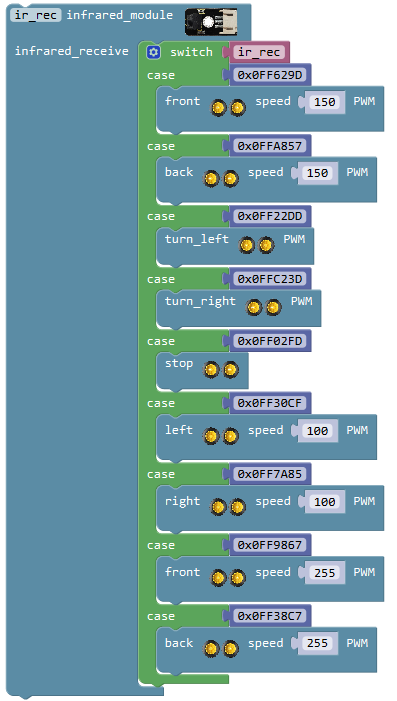
Result:
Stack the motor drive shield onto UNO board.Connect the UNO control board to computer’s USB port with USB cable to upload the code.
Upload success and turn the slide switch to ON position.
We can use infrared remote control to randomly give commands to robot car.
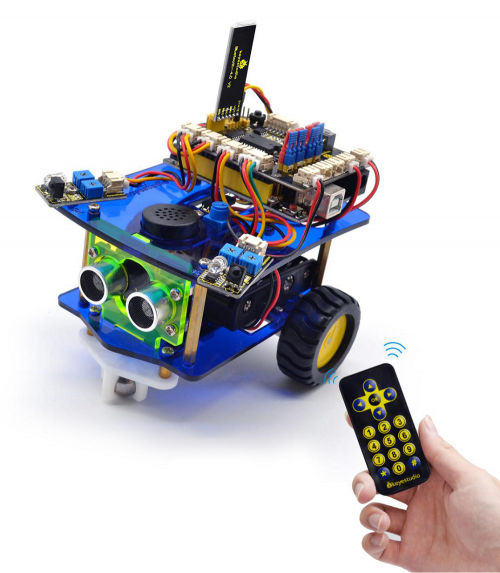
Project 14: Bluetooth Controlled Robot
We have built an infrared control smart car. In this project we are going to make a Bluetooth control smart car. Since it is a control smart car, there should be a control terminal and a controlled terminal.
In the course, we use the mobile phone as the console (host), and the HM-10 Bluetooth module (slave) connected to smart car as the controlled terminal.
When using, we need to install an APP on the phone, and connect the HM-10 Bluetooth module, then we use the buttons on the Bluetooth APP to control the smart car to achieve various motion states.
Bluetooth Remote Control
Bluetooth technology is a wireless standard technology that enables short-distance data exchange between fixed devices, mobile devices, and building personal area networks (using UHF radio waves in the ISM band of 2.4 to 2.485 GHz).
The robot kit is equipped with the HM-10 Bluetooth module, which is a master-slave machine. When use as the Host, it can send commands to the slave actively; when use as the Slave, it can only receive commands from the host.
The HM-10 Bluetooth module supports the Bluetooth 4.0 protocol, which not only supports Android mobile, but also supports iOS system.
In the experiment, we default to use the HM-10 Bluetooth module as a Slave and the cellphone as a Host.
We install the Bluetooth APP on the mobile phone, connecting the Bluetooth module; finally use the Bluetooth APP to control the robot car move, or to control the working status of other sensor modules on the robot car.
We provide you with 2 types of mobile APP, for Android and iOS system.
In this project, tap the forward button of the Bluetooth APP to control the buzzer sound. When the Bluetooth APP is successfully connected to the Bluetooth module, press the forward button of the Bluetooth APP, and the buzzer makes a small "click,click,click"; release the button to turn off the buzzer.
Parameters of HM-10 Bluetooth Module:
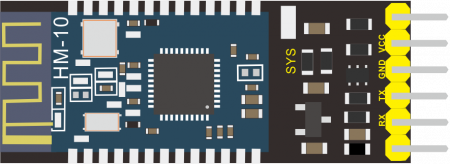
- Bluetooth protocol: Bluetooth Specification V4.0 BLE
- No byte limit in serial port Transceiving
- In open environment, realize 100m ultra-distance communication with iphone4s
- USB protocol: USB V2.0
- Working frequency: 2.4GHz ISM band
- Modulation method: GFSK(Gaussian Frequency Shift Keying)
- Transmission power: -23dbm, -6dbm, 0dbm, 6dbm, can be modified by AT command.
- Sensitivity: ≤-84dBm at 0.1% BER
- Transmission rate: Asynchronous: 6K bytes ; Synchronous: 6k Bytes
- Security feature: Authentication and encryption
- Supporting service: Central & Peripheral UUID FFE0, FFE1
- Power consumption: Auto sleep mode, stand by current 400uA~800uA, 8.5mA during transmission.
- Power supply: 5V DC
- Working temperature: -5 to +65 Centigrade
Using Bluetooth APP
- For Android system:
1.Click the Desktop_Car compression package to direct install the Desktop_Car APP; installed well, appear the icon below on your mobile phone:
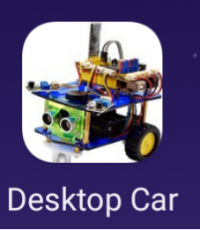
Download the Desktop_Car package from the link below:
https://drive.google.com/open?id=1mP3dCQu76xa-C3BbaECfQH0c9AaUFJek
Or you can download the keyestudio Desktop_Car APP direct from the Google Play:
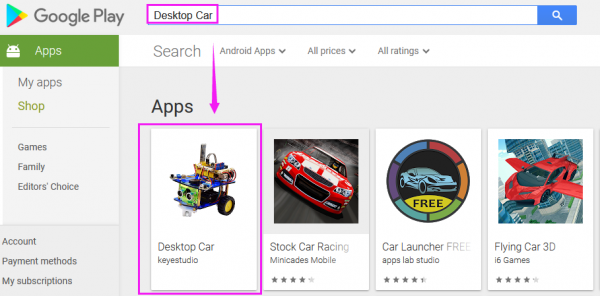
2.Tap the Desktop_Car icon to enter the Bluetooth APP. As shown below.
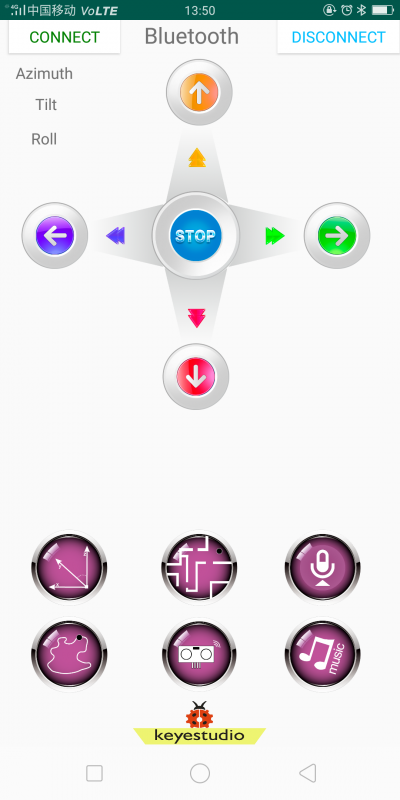
3.Done uploading the code to UNO R3 board, connect the Bluetooth module, the LED on the Bluetooth module will flash.
Then tap the option CONNECT on the APP, searching the Bluetooth.
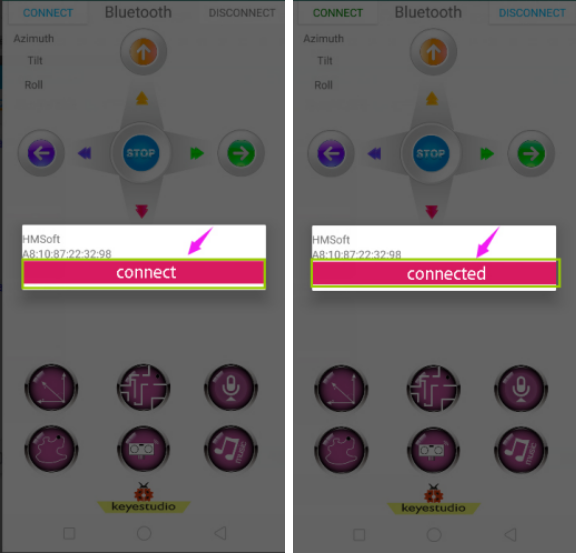
4.Click to connect the Bluetooth. HMSoft connected, Bluetooth LED will turn on normally.
5.Click the up button  on the APP, buzzer will make a sound “click, click”; release the button, buzzer will turn off.
on the APP, buzzer will make a sound “click, click”; release the button, buzzer will turn off.
For iOS system:
1.Open the APP store

2.Click to search keyestudio, and you will see the keyes BT car.
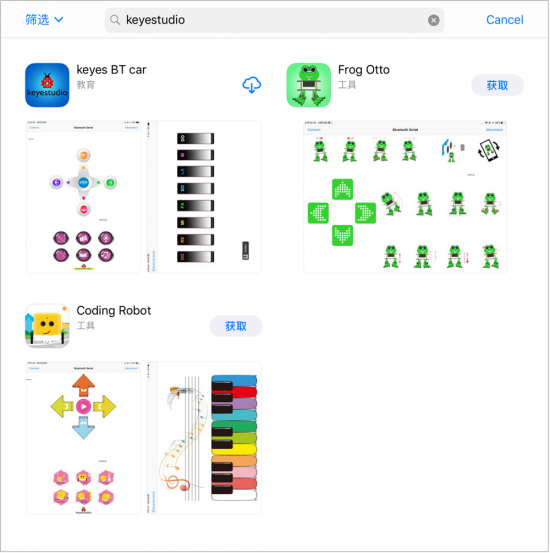
3.Tap to open the keyes BT car
4.To open Bluetooth, click the “Connect” on the upper left corner, searching and connecting Bluetooth.
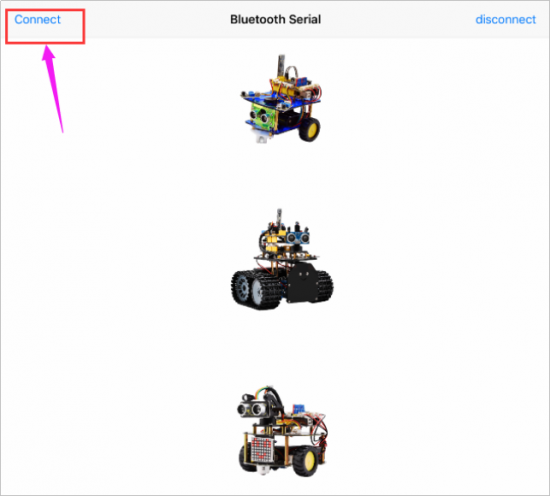
5.Tap the Desktop_Car icon to enter the control interface.
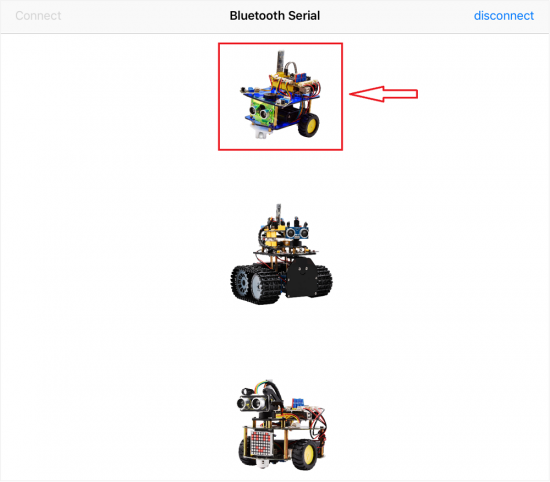
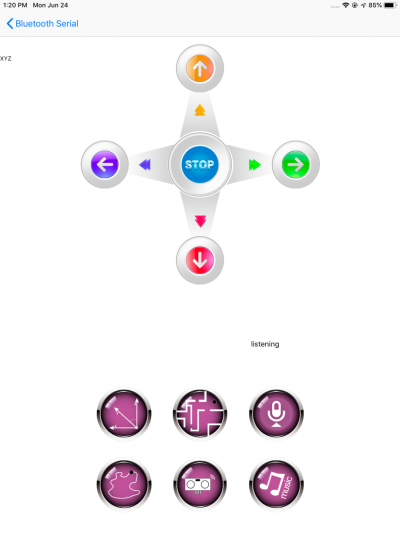
6.Click the music icon ![]() to open the music control interface.
to open the music control interface.
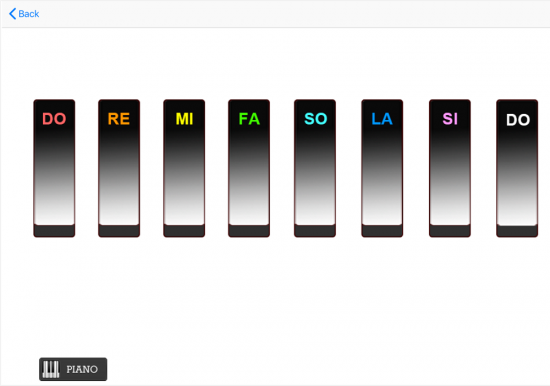
Wiring Diagram:
Connect the power amplifier module to motor drive shield with 3Pin F-F jumper wire; plug firmly the Bluetooth module into the motor drive shield; then stack the motor drive shield onto UNO control board.
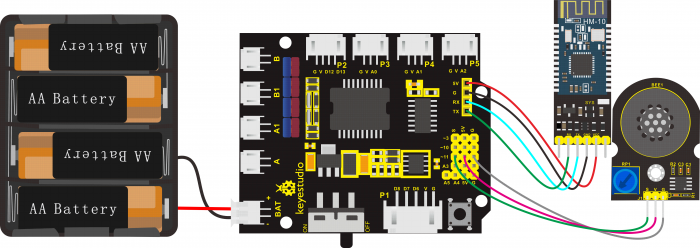
Test Code:
Pay close attention to:
CANNOT connect the Bluetooth module before upload the code, otherwise, code upload fails. You should upload the code successfully and then plug in the Bluetooth module.
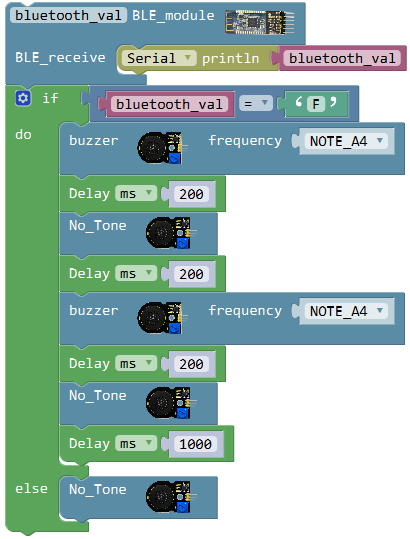
Result:
Stack the motor drive shield onto UNO board. Done wiring, connect the UNO control board to computer’s USB port with USB cable to upload the code.
Make sure you have installed the Bluetooth APP on mobile phone. Power on the motor drive shield, Bluetooth indicator flashes and then open mobile APP to connect the Bluetooth module.
Bluetooth connected, press the Up button on the Bluetooth APP, buzzer will make a sound “click, click” ; release the button, buzzer will switch off.
Bluetooth Control Robot
We’ve already learned to drive the buzzer speaker sound using the up button  on Bluetooth APP.
on Bluetooth APP.
Based on that, we can extend several buttons to control the motor drive shield and other sensor modules on the robot car.
Now get ready to give the robot car an extra function --Bluetooth Remote Control!
Below we have listed each button on the Bluetooth APP and what each button features.
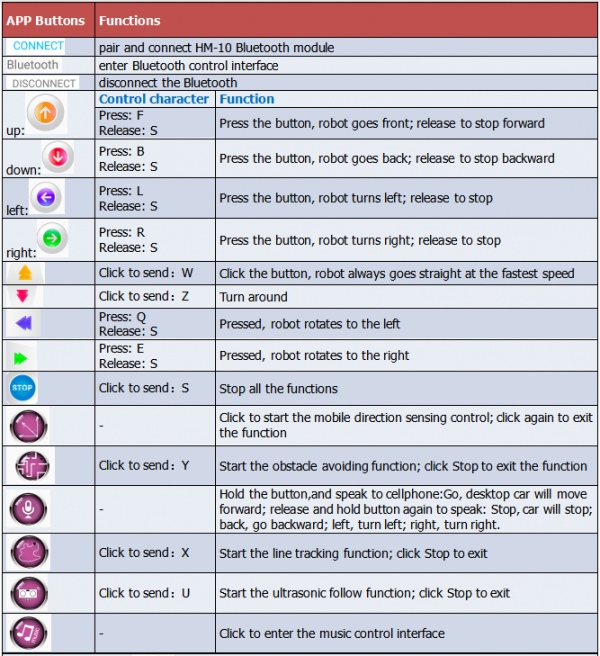
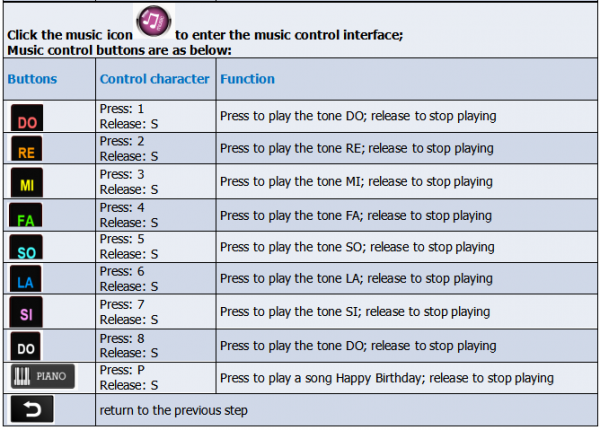
Build Bluetooth Control Robot:
Based on the designed circuit, we are going to build a Bluetooth remote control desktop car.
Follow the wiring diagram and test code below.
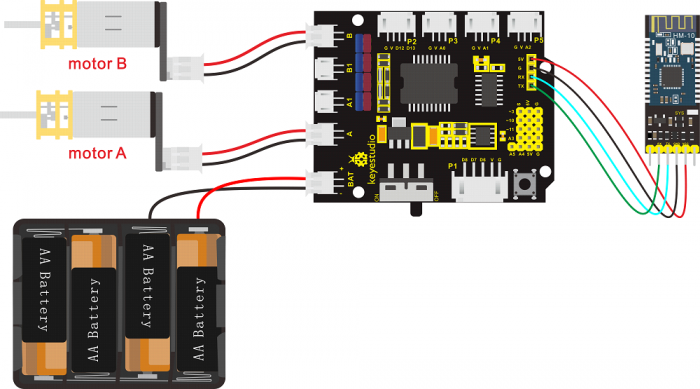
Code:
Note: should upload the code success then plug in Bluetooth module on the tank robot. Otherwise, code upload fails.
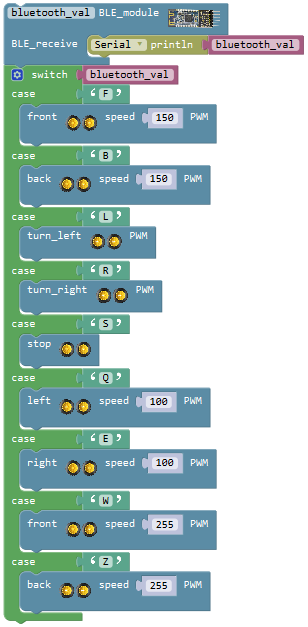
Result:
Stack the motor drive shield onto UNO board. Connect the UNO control board to computer’s USB port with USB cable to upload the code. Turn the slide switch ON.
Make sure you have installed the Bluetooth APP on mobile phone. Power on the motor drive shield, Bluetooth indicator flashes and then open mobile APP to connect the Bluetooth module.
Bluetooth connected, we can use Bluetooth APP to randomly navigate the desktop car.
Press , go forward; press
, go forward; press , go backward; press
, go backward; press , turn left; press
, turn left; press , turn right; press
, turn right; press , stop; press
, stop; press![]() , rotate to the left; press
, rotate to the left; press![]() , rotate to the right; press
, rotate to the right; press![]() , move forward at the fastest speed; press
, move forward at the fastest speed; press![]() , turn around; press
, turn around; press![]() , start mobile direction sensing control, and tap again this button to exit the direction sensing control.
, start mobile direction sensing control, and tap again this button to exit the direction sensing control.
Project 15: Bluetooth Multi-function Robot
How to build a multi-function robot combined with all the functions we’ve learned? In this circuit, we use a complete code to program the smart car to navigate the world on its own. Pretty simple and easy to switch different functions.
Hookup Guide:
Note: should upload the code success first, then plug in Bluetooth module. Otherwise, code upload fails.
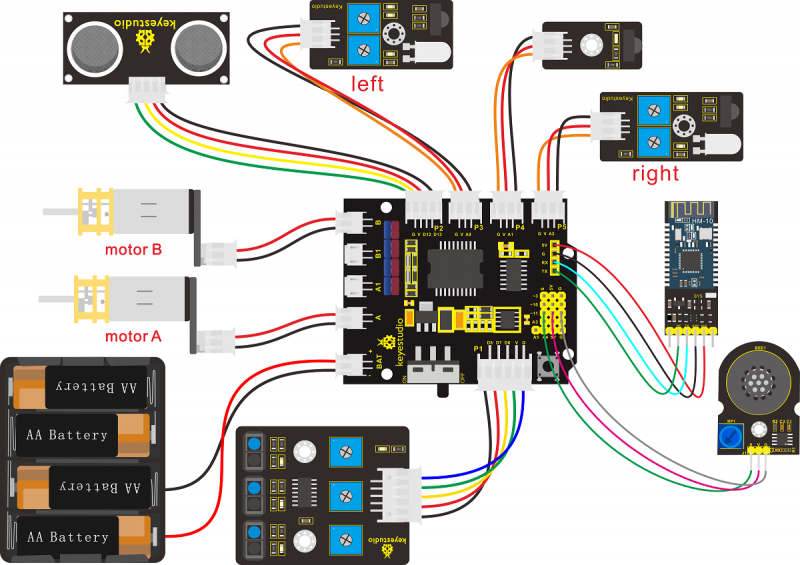
Result:
Stack the motor drive shield onto UNO board. Connect the UNO control board to computer’s USB port with USB cable to upload the code.
Turn the slide switch ON.
Connected Bluetooth module, we can use Bluetooth APP to navigate the desktop car by clicking the different buttons on the APP.
Tap Stop button to pause the function.
Note: the Android Bluetooth APP CANNOT realize the voice control![]() .
.
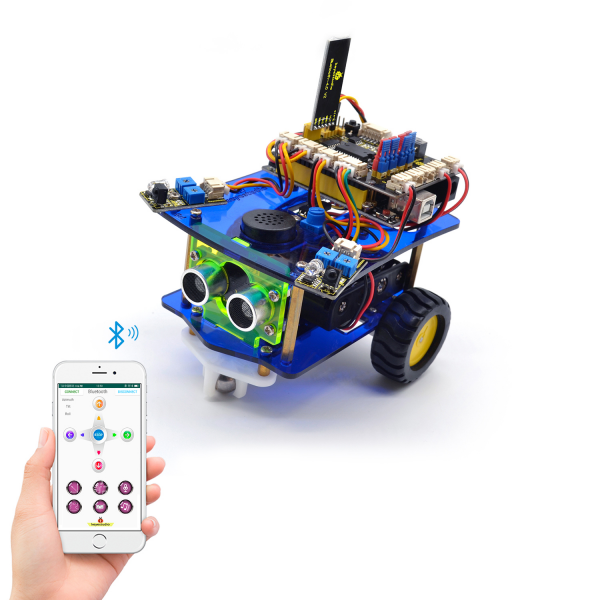
Resources
- Get all the resources here:
https://1drv.ms/u/s!ArhgRvK6-RyJcxRRe3SxqYE_X3I?e=fJHrQl
- Video:
http://video.keyestudio.com/ks0441/
About keyestudio
Located in Shenzhen, the Silicon Valley of China, KEYES DIY ROBOT co.,LTD is a thriving technology company dedicated to open-source hardware research and development, production and marketing.
Keyestudio is a best-selling brand owned by KEYES Corporation, our product lines range from Arduino boards, shields, sensor modules, Raspberry Pi, micro:bit extension boards and smart car to complete starter kits designed for customers of any level to learn Arduino knowledge.
All of our products comply with international quality standards and are greatly appreciated in a variety of different markets throughout the world.
Welcome check more contents from our official website:
http://www.keyestudio.com
For more details of our products, you can check it from the links below.
- WIKI Website: https://wiki.keyestudio.com
- US Amazon storefront: http://www.amazon.com/shops/A26TCVWBQE4D9T
- CA Amazon storefront: http://www.amazon.ca/shops/A26TCVWBQE4D9T
- UK Amazon storefront: http://www.amazon.co.uk/shops/A39F7KX4U3W9JH
- DE Amazon storefront: http://www.amazon.de/shops/A39F7KX4U3W9JH
- FR Amazon storefront: http://www.amazon.de/shops/A39F7KX4U3W9JH
- ES Amazon storefront: http://www.amazon.de/shops/A39F7KX4U3W9JH
- IT Amazon storefront: http://www.amazon.de/shops/A39F7KX4U3W9JH
- US Amazon storefront: http://www.amazon.com/shops/APU90DTITU5DG
- CA Amazon storefront: http://www.amazon.ca/shops/APU90DTITU5DG
- JP Amazon storefront: http://www.amazon.jp/shops/AE9VWCCXQIC6J
Customer Service
As a continuous and fast growing technology company, we keep striving our best to offer you excellent products and quality service as to meet your expectation.
We look forward to hearing from you and any of your critical comment or suggestion would be much valuable to us.
You can reach out to us by simply drop a line at: Fennie@keyestudio.com
Thank you in advance.
Buy From
